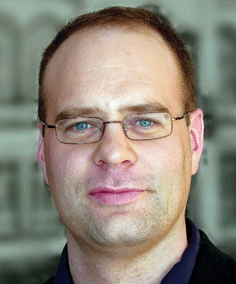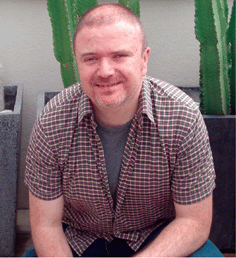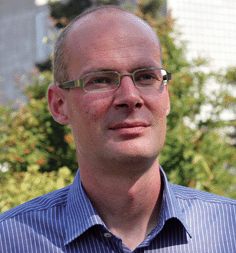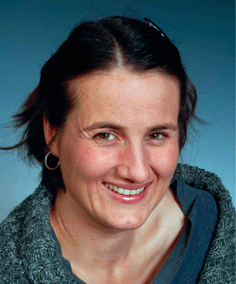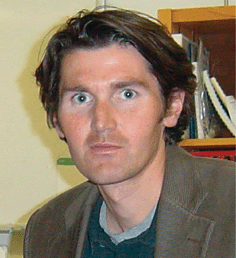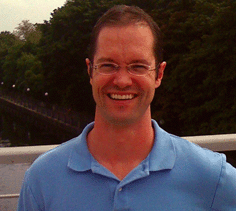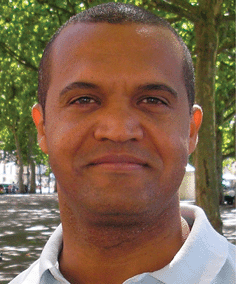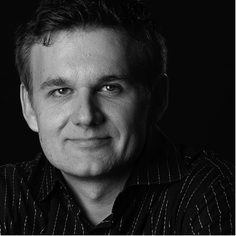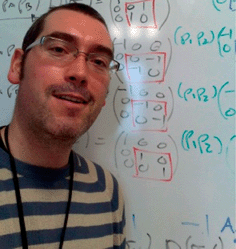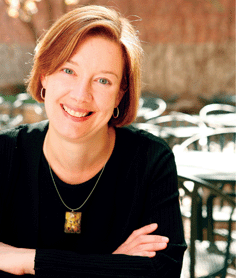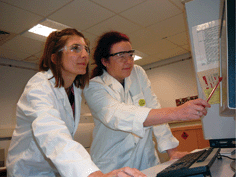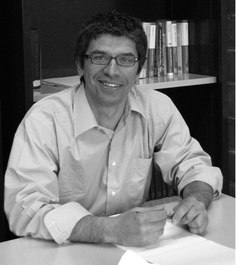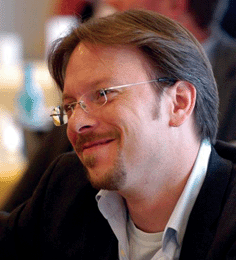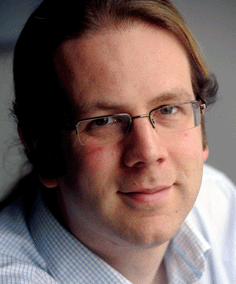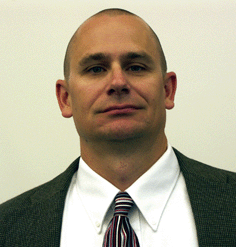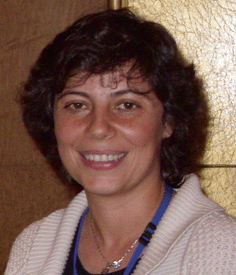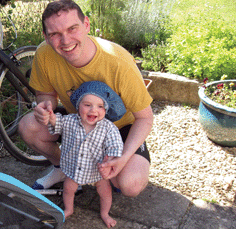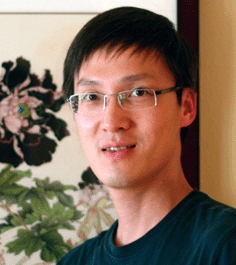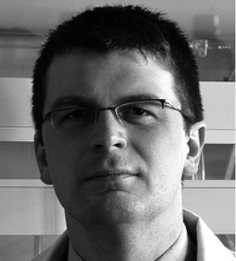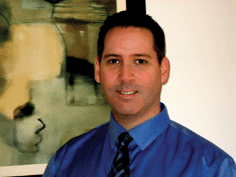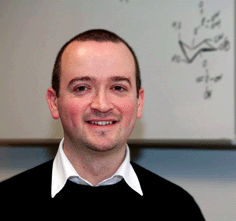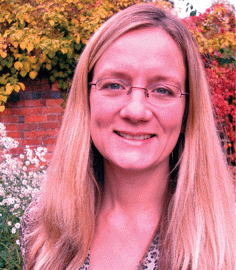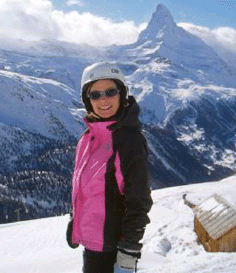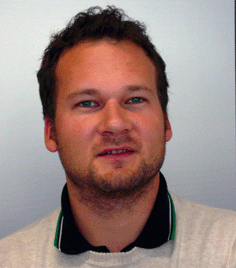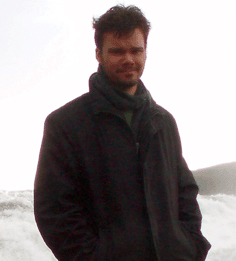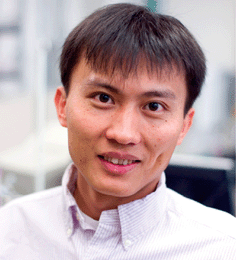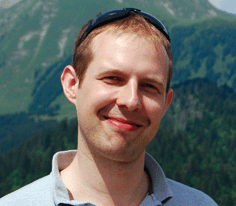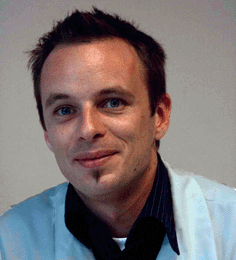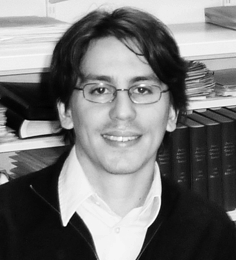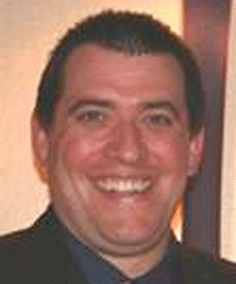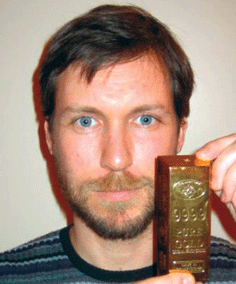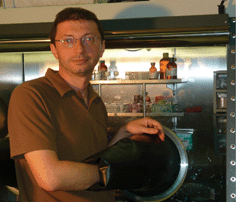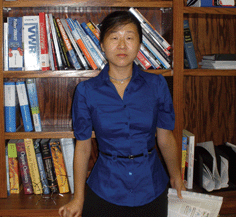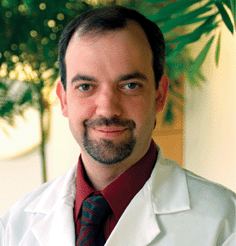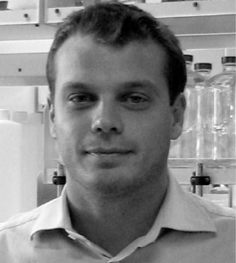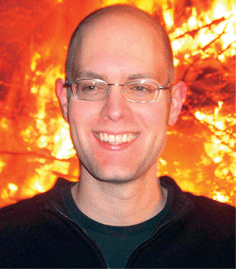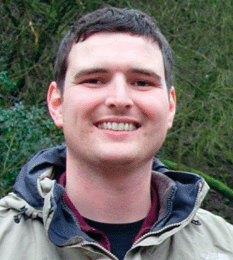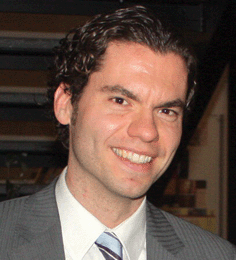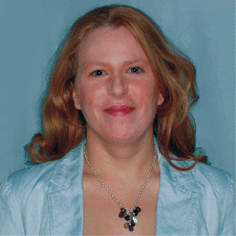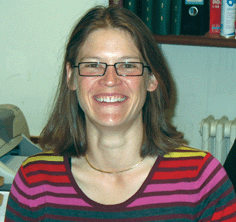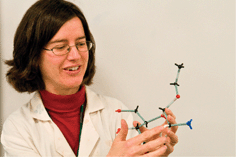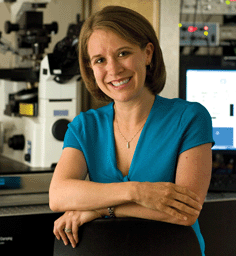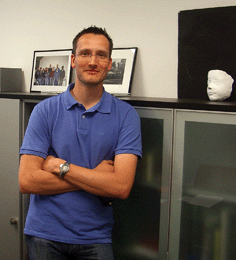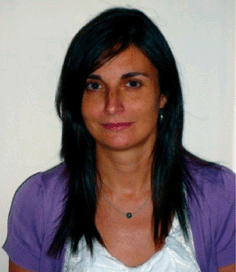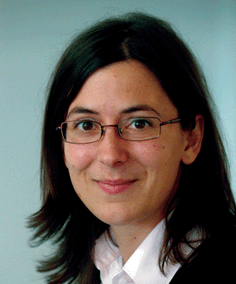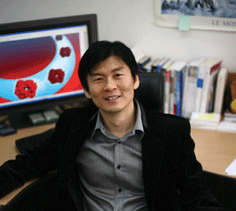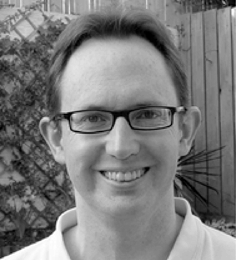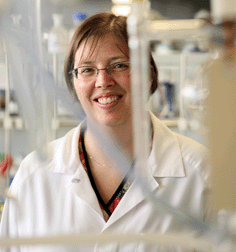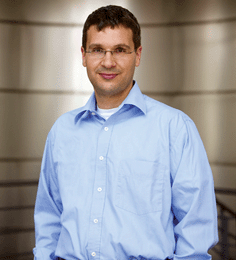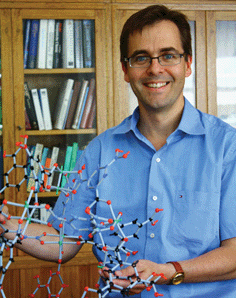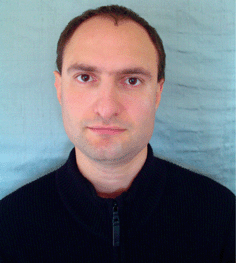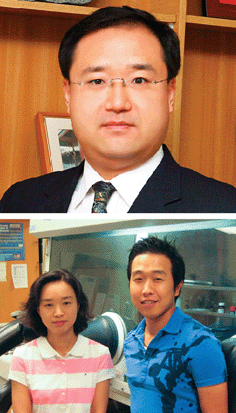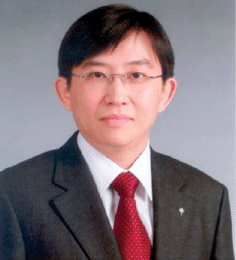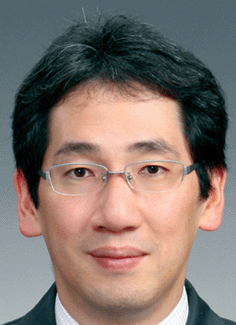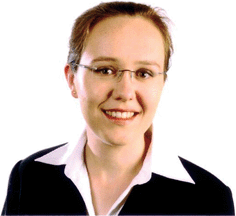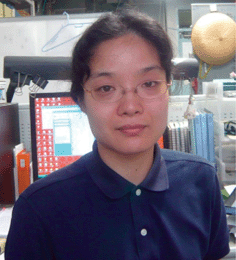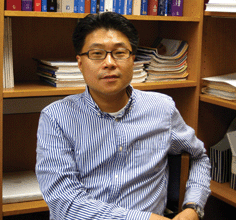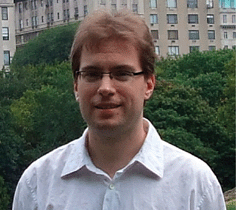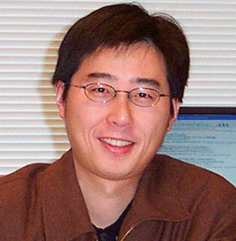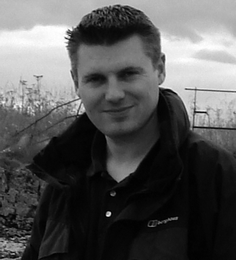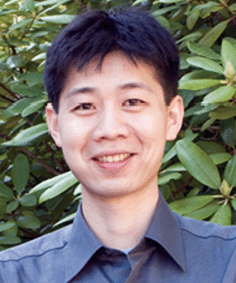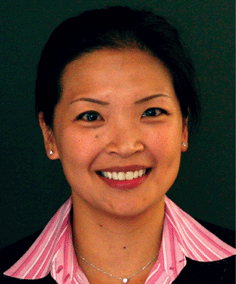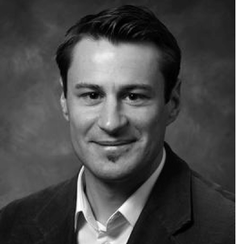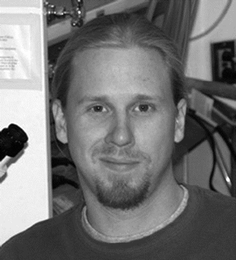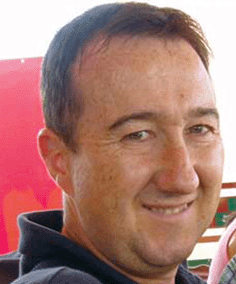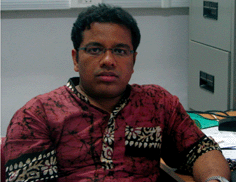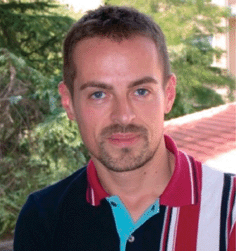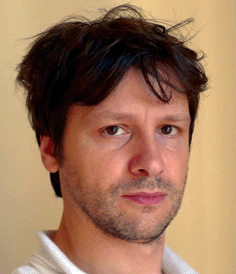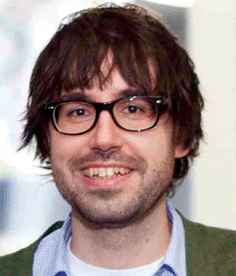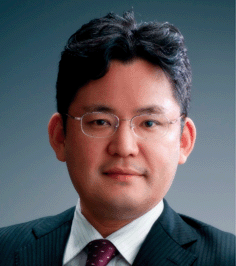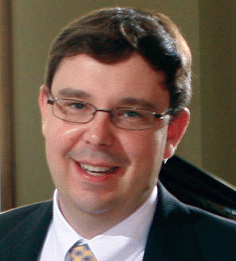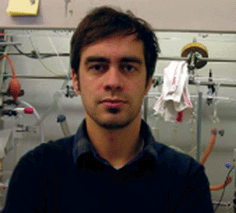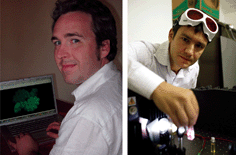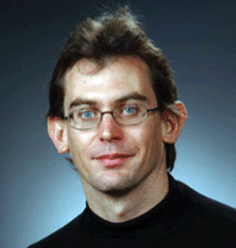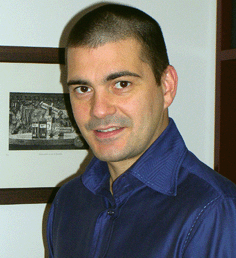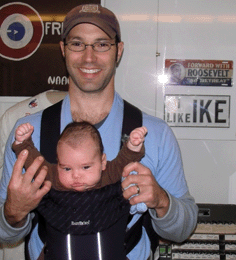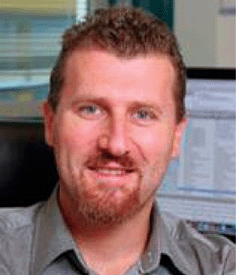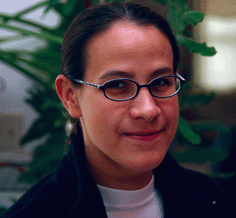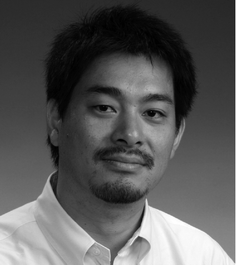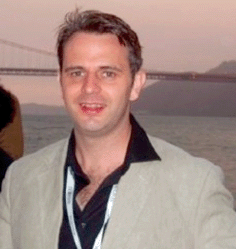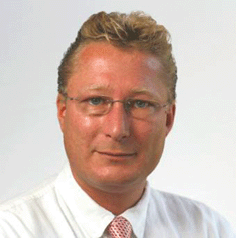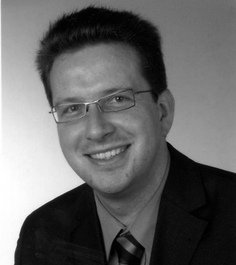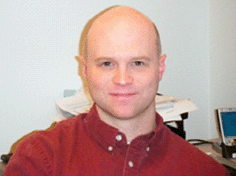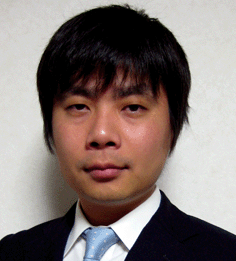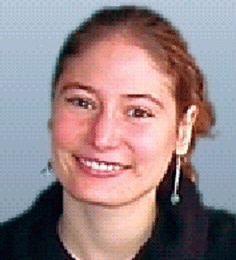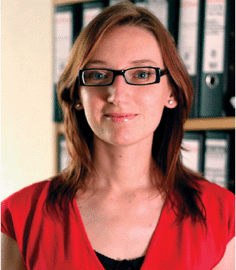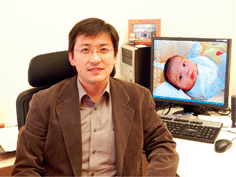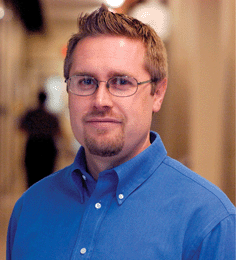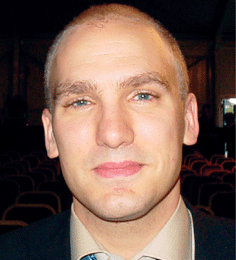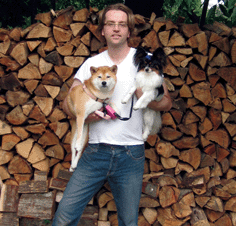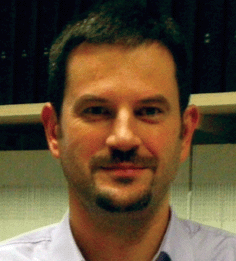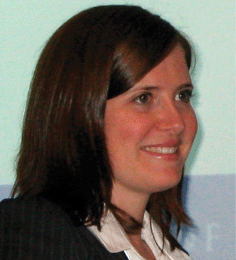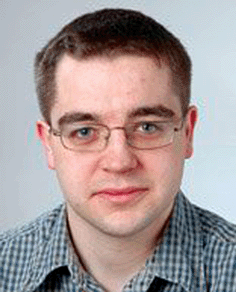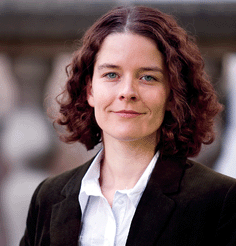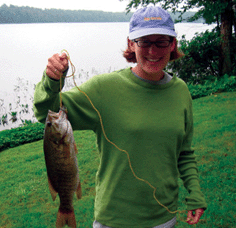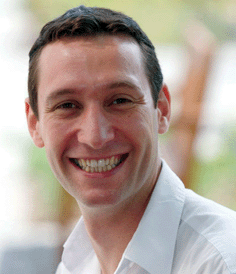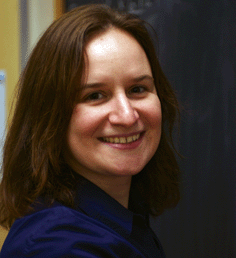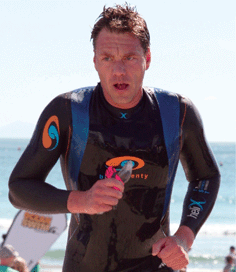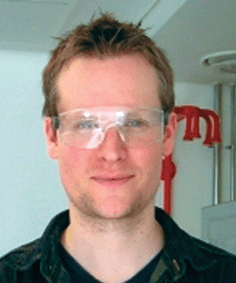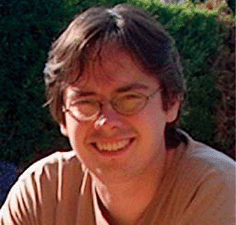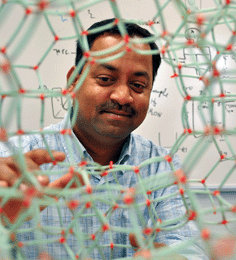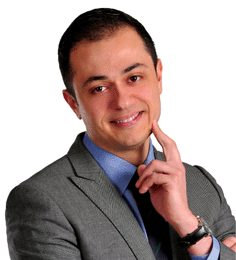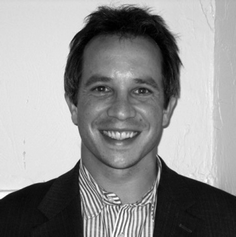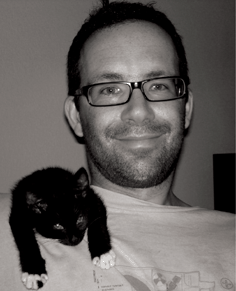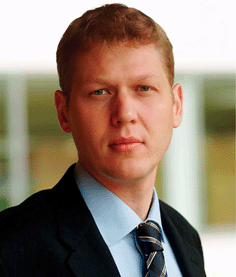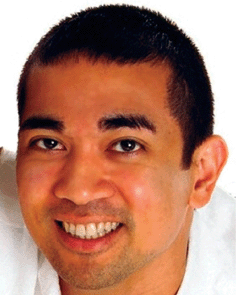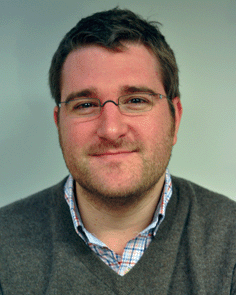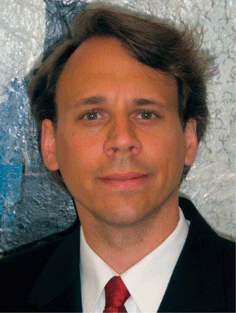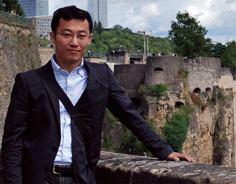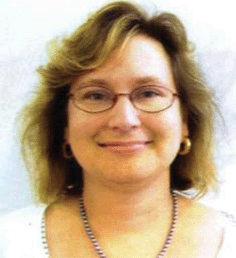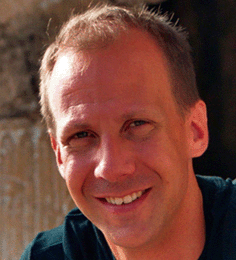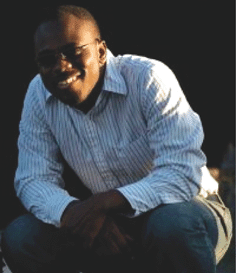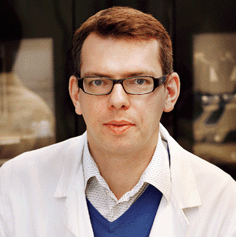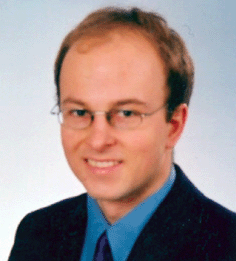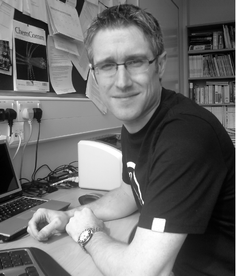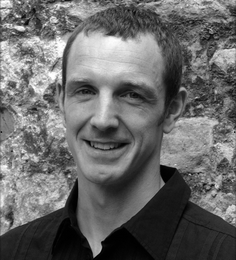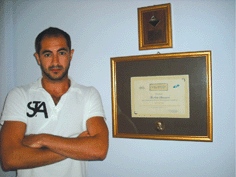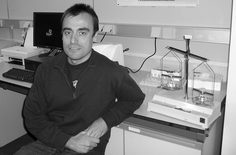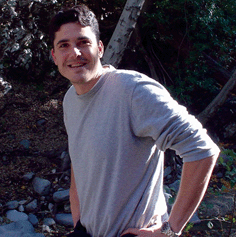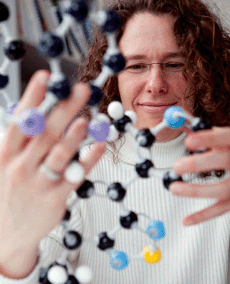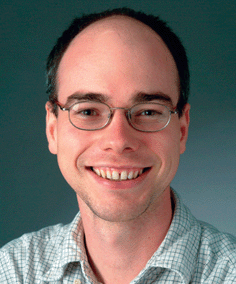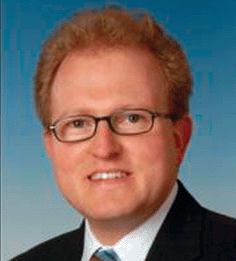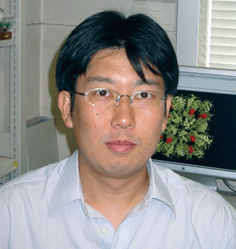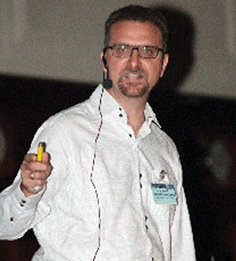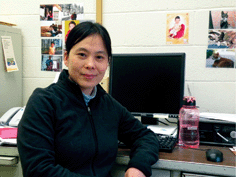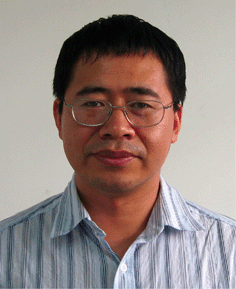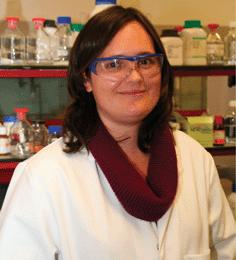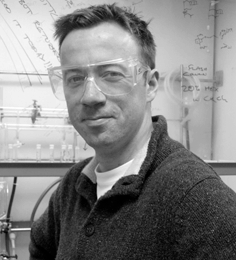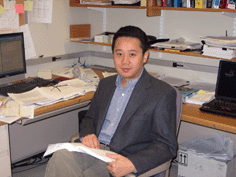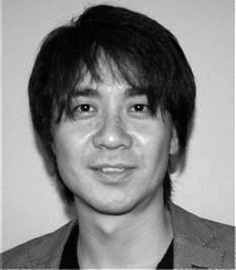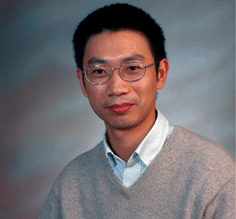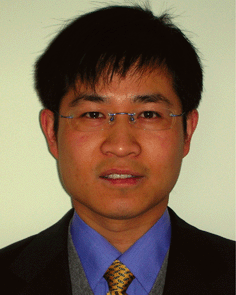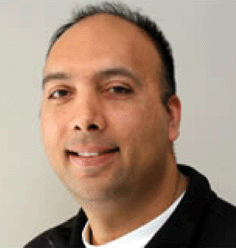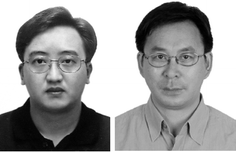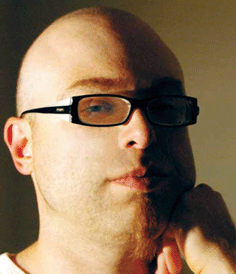DOI:
10.1039/C0CC90144J
(Profile)
Chem. Commun., 2011,
47, 51-81
Contributors to the Emerging Investigators Issue
Lutz Ackermann studied chemistry at the Christian-Albrechts-University Kiel, and obtained his PhD from the University of Dortmund in 2001 for research with Alois Fürstner at the Max-Plank-Institut für Kohlenforschung in Mülheim/Ruhr. He was a postdoctoral fellow in the research group of Robert G. Bergman at UC Berkeley (2001–2003), before initiating his independent career at the Ludwig-Maximilians-University München. In 2007, he was promoted to full professor at the Georg-August-University Göttingen. His recent awards and distinctions include an ORCHEM-price, a Dozentenstipendium and a JSPS fellowship, as well as visiting professorships at the Università degli Studi di Milano, and UW Madison.
Alexander Alexeev is an Assistant Professor in the George W. Woodruff School of Mechanical Engineering at the Georgia Institute of Technology. He obtained his PhD degree in Mechanical Engineering in 2003 from the Technion-Israel Institute of Technology. He joined Georgia Tech in 2008 after finishing his postdoctoral studies at TU Darmstadt in Germany and at the University of Pittsburgh. His research interests include modeling of multiphase fluids, fluid-structure interaction and soft materials.
Ignacio Alfonso graduated in Chemistry with Honors in 1995 at the University of Oviedo. He completed his PhD Thesis (1996–1999, Extraordinary Award) under the guidance of Prof. Gotor and a post-doctoral stay at The Scripps Research Institute with Prof. Ghadiri (2000–2002 in La Jolla, USA). After two different positions as research associate at the University of Oviedo (2002–2004) and the University Jaume I in Castellón (2004–2007, Ramón y Cajal contract), he obtained a permanent position as a Tenured Scientist in the Spanish Council for Scientific Research (CSIC) where he started his independent research career. He is currently the group leader of the Supramolecular Chemistry group at the Institute of Advanced Chemistry of Catalonia (IQAC, CSIC). He is co-author of about 50 scientific publications. His main research interests are in the fields of Supramolecular and Bioorganic Chemistry.
Andreas Bach studied chemistry and received his PhD degree from the Universität Bern, Switzerland, in 2000. After two years of postdoctoral research at the University of Wisconsin-Madison he moved to ETH Zürich as a staff scientist associated with Peter Chen and became group leader in 2007. His research interests include chemical reaction dynamics, photochemistry and organometallic reactive intermediates.
Perdita Barran is currently a Senior Lecturer in Biophysical Chemistry at the University of Edinburgh. She graduated from Manchester University with a degree in Chemistry with Industrial Experience (1994), and from Sussex University with a PhD in Chemical Physics (1998). She met Dek Woolfson at Sussex in 2000 and he suggested zinc fingers as a good target for IM-MS. After a postdoctoral appointment at UCSB, Perdita was awarded an EPSRC Advanced Research Fellowship which allowed her to commence independent research at Edinburgh University (2003).
Michael H. Bartl is an Assistant Professor of Chemistry and Adjunct Assistant Professor of Physics at the University of Utah. He conducted postdoctoral research with Professor Galen Stucky at UCSB and with Professors Evelyn Hu and David Awschalom at the California NanoSystems Institute. He earned Diploma and Doctorate degrees in chemistry from the Graz University of Technology and the Karl-Franzens University Graz, Austria. His group studies functional materials for energy and information technology applications, including bioinspired photonics, nanocrystals and thin films. His honors include an “Outstanding Scientific Achievement” award, a Max-Kade Fellowship and he is currently a “DuPont Young Professor”.
André Beauchemin was born in 1974 (Quebec city). After receiving his BSc from Université Laval (1996), he studied under the guidance of André B. Charette (Université de Montréal), obtaining his PhD in 2001. As a NSERC post-doctoral fellow at Harvard University (David A. Evans), he experienced “hardcore” total synthesis (azaspiracid 1). Since 2004, André is at the University of Ottawa and his research group focuses mostly on the development of metal-free π-bond amination reactivity and applications in target-oriented synthesis. Recently, André received a uOttawa Excellence in Education Award (2008) and an Ontario Early Researcher Award (2009).
Philippe Belmont was born in Paris in 1970, grew up in the French Caribbean, in 1990 moved to the Université Joseph Fourier (Grenoble, France) where he obtained in 1996 a PhD in Organic Chemistry, under the guidance of Dr M. Demeunynck and Pr. Jean L’homme. Then, he moved successively as a post-doctoral fellow at Case Western Reserve University (Pr. A. J. Pearson, Cleveland, USA) and to the Collège de France (Pr. J.-M. Lehn and Dr J.-P. Vigneron, Paris, France). In 2000 he joined the group of Pr. M. A. Ciufolini (Université de Lyon, France) as a Researcher for the Centre National de la Recherche Scientifique (CNRS). Finally, in 2004 he obtained the habilitation diploma and since manages a research group dealing with organometallic chemistry (Rh, Au, Ag, Co) for the synthesis of nitrogen and oxygen-containing heterocyclic compounds, with an interest for their biological properties. In 2009 he moved to the Institut Curie in Paris.
Christopher W. Bielawski’s interest in chemical research began when he was an undergraduate working the laboratories of Professor Jeffrey S. Moore at the University of Illinois, Urbana-Champaign. After receiving his BS degree in chemistry in 1997, he moved to the California Institute of Technology (Pasadena, CA) where he studied under the mentorship of Professor Robert H. Grubbs. Soon after finishing his PhD in chemistry in 2003, he moved back east (slightly) and began a postdoctoral appointment in the laboratories of Professor David A. Tirrell (also at Caltech). In 2004, he launched a program at The University of Texas at Austin that is synthetic in nature and focuses on addressing issues at the interface of polymer, organic, and materials chemistry.
Chris Blackman. My interests are in the use of novel inorganic synthesis techniques in developing new functional materials for advanced device fabrication in areas such as energy, sensing, data storage and microelectronic applications. Principally, I am interested in the use of vapour synthesis for deposition of thin films of complex or highly structured materials, although I am also working on application of metastable materials synthesis routes, such as high pressure/temperature and hydrothermal syntheses, to access metastable phases with unique functional properties.
Helen Blackwell was born in Ohio and received her BA from Oberlin College in 1994. She received her PhD in 1999 at Caltech working with Prof. Robert Grubbs, and then spent three years as a postdoctoral fellow with Prof. Stuart Schreiber at Harvard. In 2002, she returned to the Midwest and joined the faculty of the University of Wisconsin-Madison, where she is currently Associate Professor of Chemistry. Helen has established a research program at the very interface of organic chemistry and bacteriology, and her broad goal is to understand the role of chemical signals in host–bacterial interactions and infectious disease.
Oksana Leszczyszyn and
Claudia Blindauer. The picture shows Dr Oksana Leszczyszyn and Dr Claudia Blindauer, the major contributors to this manuscript. Both work at the University of Warwick and are shown indulging in their second-most favourite analytical technique, namely native electrospray ionisation mass spectrometry. Dr Blindauer studied in Germany and Switzerland with Profs. Heinrich Vahrenkamp and Helmut Sigel, before continuing her post-doctoral career at the University of Edinburgh with Prof. Peter Sadler. In 2004, she took up her Royal Society Olga Kennard Fellowship at the University of Warwick, where she now is an Associate Professor. Dr Leszycyszyn began working with Dr Blindauer for her PhD in December of the same year and took up a post-doctoral appointment with Dr Blindauer in April 2008.
Davide Bonifazi was born in Guastalla (Italy) in 1975. After obtaining the “Laurea” from the University of Parma (IT, 1994–1999) working with Prof. E. Dalcanale, he joined the group of Prof. F. Diederich as doctoral fellow at the ETH Zürich (CH, 2000–2004). For his doctoral dissertation, he was awarded the Silver Medallion of the ETH (2005). After a one-year postdoctoral fellowship with Prof. M. Prato at University of Trieste (IT), he joined the Department of Pharmaceutical Science at the same University as a research associate first and then as permanent researcher. Since September 2006, he has also joined the Department of Chemistry at the University of Namur (BE) as junior professor in organic chemistry. His activities are focused on the creation of functional supramolecular organic architectures in interdisciplinary projects through targeted organic synthesis, self-assembly of hybrid architectures at interfaces, physical–organic studies and biomaterial design. His published works include
ca. 50 articles, two book chapters and two patents. This year, he was awarded the “Ciamician Medal” from the Organic Division of the Italian Chemical Society.
Frank Breher performed his PhD studies at the Universities of Oldenburg and Marburg (1998 to 2001) and spent his postdoctoral period at the ETH Zürich, Switzerland, where he also initiated his independent research as a Liebig-Fellow. In January 2006, he became Assistant Professor at the Universität Karlsruhe (TH). He was promoted to W3-Professor for Inorganic Chemistry at the Karlsruhe Institute of Technology (KIT) in April 2010. His research interests centre around the synthesis, structure, bonding and reactivity of organometallic and coordination compounds. Specifically, his lab is interested in multifunctional ligand systems and the chemistry of biradicaloids. All activities are based on a strong experimental background and are supplemented by various advanced spectroscopic techniques and quantum chemical calculations.
Luc Brunsveld (1975) is full-time professor of chemical biology at the biomedical engineering department of the Technische Universiteit Eindhoven. After studying chemistry with E. W. Meijer he was a post-doctoral Humboldt Fellow at the Max Planck Institute of Molecular Physiology with H. Waldmann and group leader medicinal chemistry at Organon (now MSD). In 2005 he started his own research group at the MPI in Dortmund and subsequently moved to the TU Eindhoven in 2008. His scientific interests are in nuclear receptor chemical biology and in combining supramolecular chemistry with chemical biology.
Timothy J. Bunning, PhD, is a research engineer in the Survivability and Sensor Materials Division of the Materials and Manufacturing Directorate, Air Force Research Laboratory, Wright-Patterson Air Force Base. His research interests center on responsive optical, electro-optical, and photo-optical structured organic materials (primarily polymer and liquid crystalline based) and approaches for utility in optical sensing, laser beam control, and filtering (modulation) applications. Current research areas include the development of 1-, 2-, and 3-D switchable polymeric diffractive structures using complex holographic photopolymerization techniques, dynamic cholesteric LC material systems, photosensitive liquid crystalline/polymer mixtures, novel electro-optic liquid crystal/polymer materials, novel organic coatings deposited
via plasma enhanced CVD, and nanostructured optical materials. He is the recipient of the 2002 John H. Dillon Medal from the Division of Polymer Physics, American Physical Society, and is a Fellow of APS, SPIE, and the Air Force Research Laboratory.
Sofia Calero was awarded a BSc in Chemistry from the University Complutense of Madrid (Spain), and she received a
cum laude PhD in Chemistry from the same University. After her PhD she worked for three years, two of them as a Marie Curie Fellow, with Berend Smit in the University of Amsterdam (The Netherlands). In 2004 she moved to the University Pablo de Olavide, in Sevilla (Spain) where she created the Group of Nanostructured Materials for Technological Applications. Her research involves the development of computational approaches for molecular processes in novel multifunctional nanomaterials. Sofia Calero has received the Spanish Royal Society of Chemistry Young Researchers Award, and the Marie Curie Excellence Award.
Dave Carbery graduated from The University of Strathclyde with a BSc (Hons) in chemistry. Following his PhD at The University of Sheffield, he enjoyed postdoctoral spells at The University of Oxford and Imperial College London. He was appointed to a lectureship at The University of Bath in December 2005. His research interests concern new organic methodology, the synthesis of biologically active compounds and new helical catalysts. However, in the last year Dave’s biggest challenge has been balancing the joys of fatherhood with trying to develop new flavin-catalysed reactions.
Chuo Chen, born in Taipei, Taiwan, R.O.C., received his BS degree at National Taiwan University in 1995. Following the completion of his doctoral studies in 2001 at Harvard University under the direction of Prof. Matthew D. Shair, he worked as a HHMI postdoctoral research fellow under the guidance of Prof. Stuart L. Schreiber at Harvard. He then joined the faculty at UT Southwestern Medical Center in 2004 as a Southwestern Medical Foundation Scholar in Biomedical Research, and was promoted to Associate Professor in 2010. The focus of his research program is the synthesis of natural products and Hh/Wnt inhibitors.
Mathias Christmann was born in Peine, Lower Saxony, Germany, in 1972. He studied Chemistry in Braunschweig and Hannover and obtained his PhD in 2001 under the guidance of Markus Kalesse. After a postdoctoral appointment at the University of Minnesota, he returned to Germany to pursue an independent academic career. In 2003 he joined the RWTH Aachen as a Liebig-Fellow under the auspices of Dieter Enders. Since 2008 he is Associate Professor at TU Dortmund. His research interests include organocatalysis and natural products synthesis.
Don Coltart is an Assistant Professor of Chemistry at Duke University. He obtained his Master’s degree from the University of Manitoba, under the supervision of Professor James L. Charlton, and then joined the research group of Professor Derrick L. J. Clive at the University of Alberta for his PhD studies. His postdoctoral work was conducted at the Memorial Sloan-Kettering Cancer Center, under the supervision of Professor Samuel J. Danishefsky. Don began his independent career at Duke University in 2004. His research group studies the development of methods for asymmetric carbon–carbon bond formation, particularly in the context of thioesters and activated hydrazones, and the application of those methods to the total synthesis of natural products, drugs, and related compounds.
Stuart Conway was born and raised in Sussex, England, where he completed his early education. He read Chemistry with Medicinal Chemistry at the University of Warwick and then completed PhD research under the supervision of Prof. David Jane at the University of Bristol. Stuart then moved to the University of Cambridge to undertake post-doctoral studies with Prof. Andrew Holmes FRS. Between 2003 and 2008, Stuart held a Lectureship at the University of St Andrews. In October 2008 he took up his current position, of University Lecturer, at the University of Oxford. When not involved in chemistry, Stuart enjoys spending time with his young family and supporting Charlton Athletic.
Helen J. Cooper is Senior Lecturer in the School of Biosciences at the University of Birmingham. Her research interests focus on gas-phase ion chemistry of biomolecules and other biologically-relevant species. A particular interest is radical-driven fragmentation. She obtained her BSc and PhD in Chemistry from the University of Warwick. After a brief spell in industry, she returned to the University of Warwick before moving to Florida State University in 2000. She returned to the UK to establish an independent career in 2003 and was awarded a Wellcome Trust University Technology Fellowship to establish a cutting-edge mass spectrometry programme at the University of Birmingham.
Clémence Corminboeuf. From an early scientific age, Clémence Corminboeuf has been fascinated and excited to formulate electronic-structure theories leading to paradigm-shifting ways of thinking about molecules. She earned her PhD in 2004 from the University of Geneva, followed by postdoctoral stays at New York University and the University of Georgia (USA). In 2007 she became the Sandoz Family Foundation Chair and head of the Laboratory for Computational Molecular Design at the Ecole Polytechnique Fédérale de Lausanne. In her spare time she enjoys late night scientific discussions with her chemist husband, attempting to teach her young daughter about the periodic table, and, of course, skiing in the Alps.
Nicolai Cramer studied chemistry at the University of Stuttgart from 1998 to 2003 and obtained his PhD degree with Professor Sabine Laschat in 2005. After a short research stay in Japan at Osaka University, he joined the group of Professor Barry M. Trost at Stanford as a Humboldt postdoctoral fellow. In 2007, he was awarded a Liebig-Fellowship and started his independent career as a Habilitant at the ETH Zurich under the mentorship of Professor Erick M. Carreira. His research encompasses the development of transition-metal catalyzed functionalization of C–C and C–H bonds as well as natural product synthesis.
James Crowley obtained his BSc (Hons) (1998) and MSc (2000) from Victoria University of Wellington and completed his PhD (2000–2005) at the University of Chicago under the direction of Prof. Brice Bosnich, FRS. He then joined Prof. David Leigh’s (FRS) group at the University of Edinburgh, where he was awarded a British Ramsay Memorial Trust Fellowship (2006–2008), to carry out research on molecular machines. He commenced his present position as Lecturer in the Department of Chemistry, University of Otago in 2008. His major research interests are in self-assembly, molecular recognition and the development of molecular machines.
Yi Cui went to University of Science and Technology of China, where he received a Bachelor’s degree in Chemistry in 1998. He attended graduate school from 1998 to 2002 at Harvard University, where he worked under supervision of Professor Charles M. Lieber. His PhD thesis concerned semiconductor nanowires for nanotechnology including synthesis, nanoelectroncis and nanosensor applications. After that, he went on to work as a Miller Postdoctoral Fellow with Professor Paul Alivisatos at University of California, Berkeley. His postdoctoral work was mainly on electronics and assembly using colloidal nanocrystals. In 2005 he became an Assistant Professor in Department of Materials Science and Engineering at Stanford University. In 2010 he was promoted to an Associate Professor with tenure. His current research is focused on nanomaterials for energy storage, photovotalics, topological insulators, biology and environment.
Paul Davies received his PhD in 2003 (Prof. V. K. Aggarwal) from the University of Bristol, UK, following undergraduate studies (MChem) at the University of Sheffield, UK. After postdoctoral research at the Max-Planck-Institut für Kohlenforschung, Mülheim, Germany with Prof. A. Fürstner, he joined the University of Birmingham as Lecturer and group leader in 2006. Led by a particular interest in the design of new transformations and strategies for more expedient and efficient molecular synthesis, his research group are exploring catalysis-based reaction development and its application.
Gwilherm Evano studied chemistry at the Ecole Normale Supérieure in Paris and received his PhD from Université Pierre et Marie Curie in 2002 under the supervision of François Couty and Claude Agami. After a most enjoyable postdoctoral stay with James Panek at Boston University, he joined the CNRS as Chargé de Recherche at the University of Versailles in 2004 and obtained his habilitation in 2009. His research interests focus on asymmetric synthesis and reactivity of nitrogen heterocycles, copper-catalyzed transformations, and the total synthesis of natural and/or biologically relevant products.
Josh Figueroa is a product of New York City Public Schools, the University of Delaware (BS; A. L. Rheingold) and the Massachusetts Institute of Technology (PhD; C. C. Cummins). He underwent additional refinement at Columbia University (G. Parkin) before arriving at the University of California, San Diego in 2007. He has had a fascination with transition metals his whole life and, for better or worse (usually worse), is an avid fan of the NY Mets. His current interests and hobbies focus on the synthesis, structure and reactivity of transition-metal complexes. He believes if Cardiolite
® has taught us anything, it is that isocyanides may save the world.
John S. Fossey received his MChem degree from Cardiff University in 2000, he then obtained a PhD from Queen Mary University of London, under the direction of Dr Christopher J. Richards, in 2003. He was awarded a Japan Society for the Promotion of Science overseas research fellowship to work with Professor Shū Kobayashi at the University of Tokyo. He joined the University of Bath in 2005 and became a lecturer at the University of Birmingham in 2008. In 2010 he was an inaugural recipient of a JSPS Re-Invitation Bridge Fellowship, he was visiting assistant professor at Tokyo Metropolitan University, and visiting professor at East China University of Science and Technology. His current research interests are in catalysis and sensing, and the development of self reporting synthetic systems.
Fabien Gagosz was born in Dreux, France, in 1974. He graduated from the Chemistry School of Strasbourg in 1997 and received the same year his Master’s degree in Molecular Organic Chemistry from the University of Strasbourg with Prof. Charles Mioskowski. He obtained his PhD degree in 2002 with Prof. Samir Z. Zard and then joined Prof. W. B. Motherwell at the University college of London in 2003 as a postdoctoral associate. He returned to the Ecole Polytechnique in 2004 where he started his independent academic career as Chargé de Recherches at the CNRS. His current research focuses on the development of new gold(
I) catalysts and their use in the design of new synthetic methodologies.
Mark Gandelman received his PhD degree in organic chemistry from the Weizmann Institute of Science in 2003 under the direction of David Milstein. He conducted postdoctoral studies in asymmetric catalysis with E. N. Jacobsen at Harvard University. In 2005 he joined the Schulich Faculty of Chemistry at the Technion – Israel Institute of Technology. His research interests encompass areas of organic and organometallic chemistry, design of novel metal-based systems with fundamentally and practically important properties with main emphasis on their use in the development of new versatile efficient catalytic methods. Other interests include new types of non-covalent assemblies and catalysis with small organic molecules.
Yan Geng received her BS in Chemistry from the University of Science and Technology of China (USTC) in 1998, PhD in Organic Chemistry from Rutgers University at New Brunswick in 2003, and pursued post-doctoral studies at the University of Pennsylvania in the Chemical and Biomolecular Engineering department from 2003–2006. She joined the University of Georgia as an assistant professor in Chemistry in Fall 2006. Her research is focused on chemical self-assembly – design & synthesis, characterization and applications.
Jason E. Gestwicki earned a PhD in Biochemistry with Professor Laura L. Kiessling at the University of Wisconsin-Madison in 2002. His thesis work involved using synthetic, multivalent ligands to probe how receptor clustering controls signal transduction. He then performed post-doctoral work with Professor Gerald R. Crabtree at Stanford University, where he developed new ways of using drug-protein hybrids to block amyloid formation. He started his independent group at the University of Michigan in 2005, where he is currently an Assistant Professor in the Life Sciences Institute. His research interests are broadly in the areas of chemical biology, drug discovery and the manipulation of protein–protein interactions.
Nathan C. Gianneschi received his BSc (Hons) at the University of Adelaide in 1999. In 2005 he completed his PhD at Northwestern University. Following a Dow Chemical postdoctoral fellowship at The Scripps Research Institute, in 2008 he became an assistant professor at the University of California, San Diego. As a Camille & Henry Dreyfus New Faculty fellow he has built a multidisciplinary program with a focus on functional materials with interests that include biomedical applications, programmed interactions with biomolecules and cells, and basic research into nanoscale materials design, synthesis and characterization.
Frank Glorius was educated in chemistry at the Universität Hannover, Stanford University (Prof. Paul A. Wender), Max-Planck-Institut für Kohlenforschung and Universität Basel (Prof. Andreas Pfaltz) and Harvard University (Prof. David A. Evans). He began his independent research career at the Max-Planck-Institut für Kohlenforschung (mentor: Prof. Alois Fürstner) in 2001 and was appointed Associate Prof. at the Philipps-Universität Marburg in 2004. Since 2007 he has been a Full Professor of Organic Chemistry at the Westfälische Wilhelms-Universität Münster. He is a dedicated teacher and his research program focuses on the development of new concepts for catalysis and their implementation in organic synthesis.
Richard Graham’s research centres around molecular models for the non-linear dynamics of polymers. In particular, he has focussed on predictive rheology, flow-induced crystallisation and DNA electrophoresis. Since 2007 he has worked as a lecturer in the School of Mathematical Sciences at the University of Nottingham, UK. Prior to this, his PhD, supervised by Tom McLeish and Oliver Harlen at the University of Leeds, was completed in 2002. This was followed by post-doctoral work with Ron Larson (Chemical Engineering, University of Michigan, USA) and Peter Olmsted at the (School of Physics and Astronomy, University of Leeds).
Christian P. R. Hackenberger, born 1976 in Osnabrück (Germany) studied chemistry first in Freiburg and then at the University of Madison, WI, where he completed his MSc in 1999 with Samuel H. Gellman. From 2000 to 2003 he pursued his doctoral studies with Carsten Bolm at the RWTH Aachen. After a postdoctoral stay with Barbara Imperiali (2003–2005) at the Massachusetts Institute of Technology (MIT) he moved to the Freie Universität Berlin where he is heading an independent Emmy–Noether research group. The research interests of the Hackenberger group focus on the development of chemical tools for biological investigations and protein synthesis, in particular chemoselective reactions for the acquisition of modified peptides and proteins, as well as the elucidation of the biological function and structure of modified peptides and proteins.
Amanda J. Haes is currently an Assistant Professor in the Chemistry Department at the University of Iowa. She completed her PhD in Chemistry at Northwestern University with Richard P. Van Duyne. Before beginning her independent career, she was a National Research Council Research Associate with Greg E. Collins at the U.S. Naval Research Laboratory. Haes group research activities include designing and purifying novel nanomaterials for stable spectroscopic studies, improving detection limits of biological and environmental pathogens, and investigating how surface chemistry impacts nanomaterial function in separations and spectroscopy.
Michaele J. Hardie obtained a PhD from the University of Melbourne, Australia in 1996, working with Richard Robson and Bernard Hoskins on the topic of infinite framework chemistry. After various postdoctoral posts including at the University of Toledo with A. Alan Pinkerton and Monash University with Colin L. Raston, she took up a lecturing position at the University of Leeds in 2001 where she is currently a Reader in Supramolecular Chemistry. Her research interests are in metallo-supramolecular chemistry, new host molecules, crystal engineering and small molecule crystallography.
Joanne Harvey. Small and strained. Large and disordered. These may well be fitting descriptions of Dr Joanne Harvey and her office, but they are intended to portray the range of chemistry that is undertaken in the Organic Synthesis research group at Victoria University of Wellington. Joanne is delighted to have returned (in 2004) to her alma mater, where she obtained a first class BSc(Hons) degree in 1995, to research and teach organic chemistry. Joanne undertook her PhD studies at the Australian National University with Martin Banwell, followed by Anglo-Australian and Ramsey Memorial Post-doctoral Fellowships at the University of York, working in Richard Taylor’s group, before returning to New Zealand.
Christy Haynes was an undergraduate at Macalester College, a graduate student at Northwestern University, and a postdoctoral fellow at University of North Carolina, Chapel Hill – all in the field of Chemistry. She currently mentors a group of nine doctoral students and as many undergraduate researchers at the University of Minnesota where her group develops analytical techniques to explore questions in immunology, toxicology, and hematology while also keeping an active materials chemistry effort. When not working, Christy does urban scavenger hunts with her group members, bakes, and plays with her 2½ year old son.
Stefan Hecht (1974) carried out his undergraduate studies in chemistry at Humboldt Universität zu Berlin (Germany) and obtained his PhD from the University of California, Berkeley (U.S.A.) in 2001, working under the guidance of Prof. Jean M. J. Fréchet. After establishing his own research group at Freie Universität Berlin (2001–2004), he has been a group leader at the Max-Planck-Institut für Kohlenforschung in Mülheim an der Ruhr (2005–2006). Since 2006 he has held the Chair of Organic Chemistry and Functional Materials in the Department of Chemistry at Humboldt-Universität zu Berlin. His research interests are centered around synthetic macromolecular and supramolecular chemistry and its application in nanoscience and material science.
Eva Hevia. Originally from Gijón (Spain), Eva Hevia received her MSci degree in Chemistry from the Universidad de Oviedo (Spain) in 1998. She obtained her PhD degree from the same institution in 2002 under the supervision of Professor Victor Riera and Dr Julio Pérez. She then moved to the University of Strathclyde (Glasgow) as a Marie Curie Fellow to work with Professor Robert Mulvey. Currently she holds a Royal Society University Research Fellowship at the University of Strathclyde where she has recently been promoted to Senior Lecturer. Her research focuses on the design and exploitation of novel main group organometallic reagents for synthesis, including bimetallic systems (ates) and has recently been recognised with the award of the RSC Harrison-Meldola Medal (2009).
Anja Hoffmann-Röder studied chemistry at the University of Bonn and completed her PhD on metal-mediated syntheses with allenes at the University of Dortmund with N. Krause in 2003. After postdoctoral work as an Emmy–Noether Fellow with F. Diederich at the ETH Zurich (synthesis of fluorinated thrombin inhibitors), she started her independent research as a Liebig Fellow at the Johannes Gutenberg-Universität Mainz in 2005. There, she has been the head of an Emmy–Noether Group on carbohydrate chemistry since 2006 and was appointed as a Junior Professor for Bioorganic Chemistry in 2009. Her main research interests focus on the synthesis of tumour-related glycopeptides and carbohydrate antigen mimics for cancer immunotherapy.
Hyotcherl Ihee received his undergraduate degree at KAIST in 1994 and obtained a PhD degree at Caltech in 2001. As a graduate student with Prof. Ahmed Zewail, he contributed to the development of ultrafast electron diffraction. For his postdoctoral work with Prof. Keith Moffat at the University of Chicago, he studied protein structural dynamics
via time-resolved X-ray crystallography. After joining the faculty at KAIST in 2003, he has contributed to the advancement of time-resolved X-ray solution scattering. His research interests include molecular structural and chemical reaction dynamics investigated with time-resolved X-ray/electron diffraction (scattering) and spectroscopy.
Stuart James is a Reader in Inorganic Chemistry at Queen’s University Belfast. He is interested in solvent-free synthesis (mechanochemistry), porous liquids, self-assembly (the topic of this article and playing the guitar. He previously obtained a PhD in phosphine coordination chemistry with Paul Pringle and held post-doctoral positions with Jean-Pierre Sauvage (Royal Society Post-doctoral Fellowship), Gerard van Koten, Paul Raithby and Mike Mingos (Fixed-Term Lectureship at Imperial College London).
Kate Jolliffe received her PhD from the University of New South Wales, Australia then held positions at Universiteit Twente in The Netherlands, The University of Nottingham in the UK and the Australian National University before taking up an Australian Research Council QEII fellowship at The University of Sydney in 2002. She is currently Professor of Chemistry at the University of Sydney. Her research interests encompass elements of synthetic organic chemistry, supramolecular chemistry and medicinal chemistry with a focus on the use of cyclic peptides in all three areas.
Markus Kaiser studied chemistry at the universities in Frankfurt and Tübingen. He obtained his PhD degree at the Max-Planck-Insitute of Biochemistry in Martinsried under supervision of Prof. Luis Moroder and performed postdoctoral studies in Jean-Marie Lehn’s laboratory at the Collège de France in Paris. In 2005, he returned to Germany to start his own independent research career, working at the Chemical Genomics Centre of the Max Planck Society in Dortmund. Since 2010, he is full professor at the interdisciplinary Center for Biomedical Research (ZMB) of the University of Duisburg-Essen. His main research interests are the development of small molecule probes for applications in chemical (plant) biology or medicine as well as chemical biology approaches for studying the regulation, mechanism and function of cellular proteases.
Stefan Kaskel received his PhD in Inorganic Chemistry from Tübingen University in 1997. He was a Postdoctoral Humboldt-Fellow with Professor J. D. Corbett at the Ames Lab (USA). In 2000 he joined the MPI for Coal Research (Mühlheim a.d. Ruhr), as a group leader. Since 2004 he has been a full Professor in Inorganic Chemistry at the Dresden University of Technology and 2008 he was co-appointed at the Fraunhofer Institute for Material and Beam Technology as head of the CVD and thin film department. His research interests include synthesis and characterization of porous and nanostructured materials.
Alexander Katz was born in Minsk, Belarus and immigrated to the United States at age four with his family. Alex and his parents moved to Minnesota. He graduated University of Minnesota with highest honors as a Bachelor of Chemical Engineering in 1992 and a research MS in Chemical Engineering with Prof. Michael D. Ward as advisor. It was at that time that he first became inspired by chemical engineering on the molecular level and controlling properties of functional materials
via synthesis. He was awarded a Fannie and John Hertz Foundation Fellowship for doctoral studies in catalyst synthesis and characterization with Prof. Mark Davis at California Institute of Technology in 1994, and later, in 1998, undertook postdoctoral studies in supramolecular chemistry at Institut Le Bel in Strasbourg, France, with Prof. Wais Hosseini. It is there that Alex learned about calixarene macrocycles and their synthesis. Alex began a multidisciplinary research program as Assistant Professor of Chemical Engineering at UC Berkeley in 2000, and has been promoted to Associate Professor. He was a Technion-Fulbright Fellow visiting professor at the Wolfson Department of Chemical Engineering in Haifa, Israel in 2008–2009. His current research interests are focused on understanding catalysis by using comparative structure-function relations and synthesis as a tool.
Jinsang Kim is an associate professor in Materials Science and Engineering, Chemical Engineering, Biomedical Engineering, and Macromolecular Science and Engineering at the University of Michigan, Ann Arbor. He holds MS (1993) and BS (1991) from Seoul National University, Korea, and PhD (2001) in MSE at MIT. He has won several prestigious awards including 2007 NSF CAREER Award, 2006 Holt Award for excellent teaching, 2002 IUPAC Prize for Young Chemist, and 2002 ACS ICI Award. His research interests are self-signal amplifying molecular biosensors, flexible solar cells, highly emissive organic phosphors, and negative index materials sponsored by NSF, AFOSR, ARO, and DoE.
Jiseok Lee received a BS and MS in Chemical Engineering from the Hanyang University in Korea. Jiseok Lee joined Prof. Kim’s research group as a PhD student of Macromolecular Science and Engineering in University of Michigan. Jiseok Lee is currently a PhD candidate and studying the synthesis and application of polydiacetylene conjugated polymer for the development of a sensitive and selective chemo-bio sensor.
Eun Jeong Jeong obtained a BS (1993) and a MS (1995) in Chemistry from POSTECH in Korea and gained a PhD (2001) from Seoul National University under the supervision of Prof. Eun Lee. After she worked at Samsung (2001–2008), she joined the group of Prof. Jinsang Kim at University of Michigan as a research fellow (2009), currently focusing on the field of biosensor and electronic applications.
Sang Ouk Kim is an Associate Professor in the department of materials science and engineering at KAIST, Daejeon, Korea. He is the supervisor of ‘Soft Nanomaterials laboratory’ (http://snml.kaist.ac.kr/), established at KAIST in 2004. He received his PhD from chemical engineering, KAIST in the area of polymer science. His main academic interests are nanofabrication technologies relying on the directed assembly of a broad spectrum of soft nanomaterials including block copolymers, peptides, and carbon materials (carbon nanotubes or graphene).
Kazushi Kinbara was born in 1967. He received a BS degree in Organic Chemistry from the University of Tokyo in 1991, and obtained a PhD in Organic Chemistry in 1996 under the direction of Professor Kazuhiko Saigo. He then began an academic career at the University of Tokyo, and had been involved until 2001 in the development of optical resolution upon crystallization. In 2001, he moved to Professor Takuzo Aida’s group at the Department of Chemistry and Biotechnology, School of Engineering, the University of Tokyo as a Lecturer. In 2008, he was promoted to Professor of the Institute of Multidisciplinary Research for Advanced Materials, Tohoku University. His research interests include (1) development of biomimetic molecules, (2) supramolecular chemistry of macromolecules, and (3) protein engineering.
Anke Krueger was born in 1973. She studied chemistry at TU Braunschweig and Bordeaux University and received a PhD in organic chemistry from TU Braunschweig in 2000 under the direction of Prof. H. Hopf. After a postdoctoral stay with Prof. E. Osawa at Toyohashi University of Technology (Japan) she joined Kiel University as a Liebig Fellow and junior professor. Since 2008, Anke has been Professor and head of the nanocarbon materials group at the Institute of Organic Chemistry of Würzburg University. Her main interests are the synthesis, characterization, and applications of nanoscale carbon materials, playing the cello, and Japanese culture and food.
Shoko Kume was born in Kagawa, Japan in 1977. She received a DSc degree in 2004 from the University of Tokyo. Following postdoctoral fellowship at Kyushu University in Prof. Nobuo Kimizuka’s group, she has been an Assistant Professor of Prof. Hiroshi Nishihara’s group at the Tokyo University since 2006. Her current research interest focuses on the construction of integrated molecualr functionality from stimuli-responsive metal complexes and coordination mechanics, which undergoes transduction of photonic and electronic information.
Dongwhan Lee received BS and MS degrees in Chemistry at Seoul National University, and a PhD degree at the Massachusetts Institute of Technology with Steve Lippard. After a postdoctoral stint with Tim Swager, he began his independent career at Indiana University Bloomington in 2003, where he is currently an Associate Professor. His research program is broadly based on synthetic inorganic and organic chemistry of functional molecules and materials, with focus on mechanical coupling of artificial receptors, electrochemistry and photophysics of electronically conjugated materials, and conformational dynamics of shape-adaptive chemical architectures for molecular switching and chemical sensing. He received a National Science Foundation CAREER Award in 2005 and Alfred P. Sloan Research Fellowship in 2008.
Simon Lewis was born in London in 1978. He studied for his PhD at Imperial College London with Prof. Donald Craig. His work concerned the decarboxylative Ireland–Claisen rearrangement and its use in bifunctional substrates and for the formation of strained small rings. After gaining his PhD, Simon moved to the USA to work for Prof. Andrew G. Myers at Harvard University, joining a team working on the total synthesis of novel tetracycline antibiotics. In 2008 he returned to the UK to his current position at the University of Bath. His current research interests include microbial arene oxidation for synthesis, azasugars, C–H activation and dye-sensitised solar cells.
Shuwei Li received his BS degree from Peking University in China and PhD degree from Prof. Richard Robert’s group at California Institute of Technology in 2003. From 2003 to 2005, he was a postdoctoral fellow in Prof. Thomas Kodadek’s group at University of Texas Southwestern Medical Center. He joined the Center for Advanced Research in Biotechnology (now the Institute of Bioscience and Biotechnology Research at University of Maryland College Park) as an Assistant Professor in 2005. His group is interested in developing novel technologies for proteomics and system biology research and applying them to study protein tyrosine phosphorylation.
Steve Liddle was born in Sunderland in the north east of England. He obtained his BSc (Hons) in 1997 and PhD (Prof. W. Clegg) in 2000 from Newcastle University. After postdoctoral fellowships at Edinburgh University (Dr P. Bailey), Newcastle University (Dr K. Izod) as the Wilfred Hall Research Fellow, and the University of Nottingham (Prof. P. Arnold) he was appointed to a fixed-term Lectureship at Nottingham in 2007. He subsequently took up a Royal Society University Research Fellowship and Lectureship in 2007 and he was promoted to Associate Professor and Reader in 2010. In 2009 he was awarded a European Research Council Starting Investigators Grant to investigate uranium-metal chemistry. He has published over 80 papers.
Shih-Yuan Liu was born in Hsinchu, Taiwan in 1975. His family moved to Austria when he was ten. He began his undergraduate studies in Chemistry at Vienna University of Technology in 1994. In 1997, he participated in the Trans Atlantic Science Student Exchange Program (TASSEP) at UNC, Chapel Hill. In 1998 he received his first diploma (BS equivalent) from Vienna University of Technology. He did his doctoral work at MIT with Prof. Gregory C. Fu and received his PhD degree in organic chemistry in 2003. He then pursued his postdoctoral studies in inorganic chemistry with Prof. Daniel G. Nocera, also at MIT. Prof. Shih Yuan Liu began his independent career at the University of Oregon in June 2006. His research interests includesynthetic organic/organometallic/inorganic chemistry with an emphasis on biomedical research and materials science. His research is focused on developing new methods for organic synthesis and exploring the basic science and application of boron–nitrogen heterocycles.
Yueh-Lin (Lynn) Loo is an associate professor in the Chemical Engineering Department at Princeton University. She received Bachelor’s degrees in chemical engineering and in materials science and engineering from the University of Pennsylvania and her doctoral degree from Princeton University. Loo’s research centers on developing patterning tools for organic electronic devices, and on understanding structure-function relationships in organic electrically-active materials. Her work in organic electronics has garnered numerous honors, most recently the 2010 John H. Dillon Medal from the American Physical Society.
Matthias P. Lutolf is Tenure Track Assistant Professor within the Institute of Bioengineering at the Ecole Polytechnique Fédérale de Lausanne (EPFL). He completed his undergraduate studies in Materials Science at ETH Zurich where he also carried out his PhD in Tissue Engineering with Prof. Jeffrey Hubbell. In 2005, Lutolf joined the Baxter Laboratory in Genetic Pharmacology of Prof. Helen Blau at the Stanford University. His current research activities interface biomolecular engineering with stem cell biology. In 2007 Lutolf won a European Young Investigator (EURYI) award to start up his independent research at EFPL.
David M. Lynn was born in York, Pennsylvania, in 1972. He received a BS in Chemistry from the University of South Carolina in 1994 and a PhD in Chemistry from Caltech in 1999, where he worked under the supervision of Professor Robert H. Grubbs. After a postdoctoral stint at the Massachusetts Institute of Technology with Professor Robert Langer, he joined the faculty in the Department of Chemical and Biological Engineering at the University of Wisconsin – Madison in 2002. His current interests include the design of organic materials and self-assembling systems for the delivery of DNA, proteins, and small-molecule drugs.
Leonard R. MacGillivray was born in Sydney, Nova Scotia, Canada. He is currently a Professor of Chemistry at the University of Iowa. His research focuses on processes of molecular self-assembly, particularly its application to organic synthesis and the solid state. His eureka moments in chemistry arrived swiftly while performing research in the field of supramolecular chemistry as an undergraduate in the laboratory of Mike Zaworotko, Saint Mary’s University, Halifax, Nova Scotia. The lure was then translated into a PhD with Jerry Atwood, University of Missouri-Columbia in 1998. Dr MacGillivray was elected a Fellow of the RSC in 2006 and in 2007 received a Cope Scholar Award of the American Chemical Society.
Tapas Kumar Maji, born in Mejia, West Bengal, India, obtained his MSc (1998) in Chemistry from Burdwan University, and PhD (2002) from the Indian Association for the Cultivation of Science, Kolkata. Then he joined the group of Prof. Susumu Kitagawa at Kyoto University, Japan as a JSPS post-doctoral researcher in 2002 at Kyoto University. Since August 2006, he has been a faculty fellow at the Jawaharlal Nehru Centre for Advanced Scientific Research, Bangalore. His research interests are functional molecular materials based on metal–organic coordination frameworks with unique properties like gas storage, catalysis, separation and multi-functional material. He is also involved in fabrication of bi-functional hybrid nanocomposites based on magnetic and luminescent probes. He is a recipient of the young Asian Lectureship award in 2009 from the
Chemical Society of Japan. He was chosen as one of the outstanding emerging investigators in materials science by
Journal of Materials Chemistry in 2010.
Lorenzo Malavasi got a PhD in Chemistry in 2003. He is presently Assistant Professor at the Physical Chemistry Department of the University of Pavia. He was recipient of the “Young Scientist Award” for outstanding work in the field of perovskites at the “International Conference on Perovskites” held in late 2005 in Zurich and of the “Alfredo di Braccio Prize for Chemistry 2008” from the “Accademia Nazionale dei Lincei”, awarded to a distinguished under 35-years old chemist. In 2009 he was invited to contribute to the Emerging Investigator Issue of
Journal of Materials Chemistry. He is working in several areas of solid state chemistry with particular interest in the investigation of structure-properties correlation in different kinds of functional oxides. In particular, the most investigated systems in these last years comprises solid state ionics materials for energy applications, magnetic oxides and high-temperature superconductors. He is author of more than 80 papers in the most prestigious international journals of chemistry, materials chemistry and physical chemistry.
Liberato Manna received his MSc in Chemistry from the University of Bari (Italy) in 1996 and his PhD in Chemical Sciences from the same University in 2001. During his PhD studies, and later as postdoctoral fellow, he worked at the University of California Berkeley (USA). In 2003 he moved back to Italy, as junior scientist fellow at the National Nanotechnology Lab of CNR-INFM in Lecce (Italy) where he became later responsible for the Nanochemistry Division in 2006. In April 2009 he moved to the Italian Institute of Technology in Genova (Italy) as head of the Nanochemistry Department. Since July 2010 he is also visiting professor at Delft University of Technology (The Netherlands). His research interests are the advanced synthesis, structural characterization and assembly of inorganic nanostructures, with emphasis on the development of complex, three dimensional nano-heterostructures for applications in energy-related areas, in photonics and biology.
Aurelio Mateo-Alonso (1976, Madrid, Spain) obtained his BSc (1999) and MSc (2000) degrees in Organic Chemistry from Universidad Autónoma de Madrid (Spain). In 2003, he completed his PhD at Queen Mary College, University of London (UK), under the supervision of Prof. James Utley and Dr Peter Wyatt. Between 2004 and 2009, he worked as a Postdoctoral Researcher in the group of Prof. Maurizio Prato at Università di Trieste (Italy). Since 2009, he has been leading an independent research group at the Freiburg Institute for Advanced Studies (Germany). He was one of the recipients of the Young Investigator Prize of Università di Trieste in 2007 and of the Eugen-Graetz Prize of Universität Freiburg in 2009. His research interests focus on the chemistry and supramolecular chemistry of flat and curved aromatic molecules and on their implementation in molecular devices and machines.
Shigeki Matsunaga was born in 1975 and received his PhD from the University of Tokyo (Prof. Shibasaki). He started his academic career in 2001 as an assistant professor in Prof. Shibasaki’s group at the University of Tokyo and was promoted to lecturing professor in 2008. He is the recipient of the Chemical Society of Japan Award for Young Chemists (2006), Mitsui Chemicals Catalysis Science Award of Encouragement (2009), and others. His research interests are in the development of new catalytic reactions using cooperative functions of multimetallic complexes and the synthesis of biologically active compounds. In the photo, he is enjoying sea-kayak.
Kazunori Matsuura obtained his PhD from Tokyo Institute of Technology in 1996 under the supervision of Professor Yoshio Okahata. In 1996, he joined the Department of Molecular Design and Engineering, Nagoya University as an Assistant Professor. In 2001, he moved to the Department of Chemistry and Biochemistry, Kyushu University as an Associate Professor. In 2006, he was selected as a researcher of JST PRESTO project “Structure Control and Function”. His research interests include bioconjugate chemistry, molecular recognition, and nano-assembly of biomolecules. He received The Young Scientists' Prize from the Minister of Education, Culture, Sports, Science and Technology in 2008.
Joshua Maurer received his BA and MA in chemistry from Clark University, his PhD from the California Institute of Technology with Dennis Dougherty, and was a Postdoctoral Research Associate with Milan Mrksich at the University of Chicago. As an Assistant Professor at Washington University in St. Louis, Josh's research group is interested in developing new chemical biology tools for producing patterned substrates to explore and exploit neurobiology. The group is specifically interested in the development of tools to understand complex neuronal wiring and also works on bacterial ligand-gated ion channels and biosensors.
Clément Mazet. After two years of undergraduate studies in the laboratory of the late Professor John Osborn at the University of Strasbourg (France), Clément Mazet carried out his PhD under the guidance of Professor Lutz Gade in the same university. In 2003, he moved to Basel (Switzerland) to work as a post-doctoral fellow in the group of Professor Andreas Pfaltz. In 2006 he was awarded a Marie Curie International Outgoing Fellowship and spent nearly two years working with Professor Eric Jacobsen at Harvard University (MA, USA). He joined the University of Geneva in November 2007 where his independent research centers on mechanistic and synthetic chemistry with particular emphasis on asymmetric catalysis. On his spare time, he enjoys rowing, playing chess and sharing time with his wife and two sons.
Nathan D. McClenaghan was born in Ulster in 1973 and was appointed tenured researcher in the French Centre National de la Recherche Scientifique at Bordeaux in 2003. Primary research interests consider supramolecular chemistry, notably synthesis and studies of photoactive molecules and assemblies, a fascination spawned by PhD supervisor A. Prasanna “AP” de Silva and successive European post-doc projects in Italy and France. He is the recipient of the CNRS bronze medal for physical chemistry and a laureate of the European Research Council young investigator award.
Alberto Credi was born in 1970 and became Associate Professor of Chemistry at the University of Bologna in 2001. He has been playing with light and molecules since the beginning of his research career as a graduate student in the group of Vincenzo Balzani. His research, focused on the design and investigation of photoactive nanoscale devices and machines, has received several scientific awards, including the IUPAC Prize for Young Chemists. Alberto Credi is the co-author of about 170 scientific papers (h = 42), of a monography on molecular devices and machines, and of a handbook of photochemistry.
Duncan McGillivray is at the University of Auckland, New Zealand, where his research focuses on understanding the physical bases of biological interactions, particularly looking at the structure of complex non-crystalline protein systems (including membrane proteins and protein colloids). His history using neutrons and X-rays to tackle similar problems began at the Australian National University, before a Rhodes Scholarship to Oxford University for his doctorate. Later he expanded his focus to biological problems studying protein-membrane interactions at Johns Hopkins, Carnegie Mellon and the NIST Center for Neutron Research, a broad focus that now also encompasses questions of protein folding and stability, and food physics.
Paolo Melchiorre. After graduation in 1999 and a brief stint in the biology research program at Bologna University, Italy, Paolo Melchiorre began his doctoral studies in chemistry, focusing on asymmetric metal catalysis. In 2002, he worked with Professor Karl Anker Jørgensen at Århus University, Denmark, where he worked on asymmetric organocatalysis. Passionate about this research line, he continued his independent investigations at Bologna University, where he was a research assistant from 2003 to 2009. In September 2009, Paolo, together with his wife Lorna and their two kids, moved to Tarragona, Spain, where he is an ICREA Research Professor at the Institute of Chemical Research of Catalonia (ICIQ).
Matthew P. Meyer was born in Wichita, KS, in 1971. He received his BS degrees in chemistry and mathematics from the University of Kansas in 1995 and his PhD from Texas A&M University in 2001. After serving as an NIH postdoctoral fellow in the laboratory of Judith Klinman at the University of California, Berkeley, he joined the faculty at the University of California, Merced in 2005.
Raffaele Mezzenga. After a master degree in Materials Science (NASA mission STS91) Raffaele Mezzenga obtained a PhD in Polymer Physics in 2001 from the Swiss Federal Institute of Technology, Lausanne (EPFL). He spent 2001–2002 as a postdoctoral scientist at the University of California, Santa Barbara, working on the self-assembly of polymers and colloids. In 2003 he joined as research scientist the Nestlé Research Center in Lausanne, working on the self-assembly of surfactants, natural amphiphiles and lyotropic liquid crystals. He was hired in 2005 as Associate Professor in Physics at the University of Fribourg, Switzerland and in 2009 as full professor at ETH Zurich. His research focuses on the fundamental understanding of self-assembly processes in liquid crystalline polymers, supramolecular polymers, lyotropic liquid crystals, food and biological colloidal systems.
Delia J. Milliron is a Staff Scientist at Lawrence Berkeley National Laboratory, and the Facility Director for Inorganic Nanostructures at The Molecular Foundry, a research center and user facility for nanoscience supported by the U.S. Department of Energy. She received her PhD in Chemistry from the University of California, Berkeley, in 2004. From 2004 to 2008 she worked for IBM’s research division, initially as a postdoctoral researcher and subsequently as a member of the research staff. Her research is motivated by the potential for nanomaterials to introduce new functionality to, and reduce manufacturing costs of, energy technologies. Her group’s activities span from the fundamental chemistry of nanomaterials to device integration and characterization. She is the recent recipient of an R&D 100 Award, an MDV Innovators Award, and a DOE Early Career Research Program grant
Hitoshi Miyasaka, born in 1969 in Matsumoto, Japan, obtained his BS (1992) from Shimane University, and then his MS (1994) and PhD (1997) from Kyushu University under the supervision of Prof. Hisashi Okawa and Prof. Naohide Matsumoto. Then, he joined the group of Prof. Susumu Kitagawa at Kyoto University as a postdoctoral researcher of JSPS (1998–2000). During one year from the end of 1999, he was a postdoctoral researcher at the group of Prof. Kim R. Dunbar at Texas A&M University in Texas USA. In October 2000, he became an Assistant Professor at the Graduate School of Science, Tokyo Metropolitan University. He was also a research member of the PRESTO project of Japan Science and Technology Agency (JST) in 2002–2004. Since April in 2006, he has been an Associate Professor at the Graduate School of Science, Tohoku University in Sendai. His current research interests are functional molecular materials involved in unique electronic/magnetic systems such as single-chain magnets, single-molecule magnet-based network compounds, and covalent-bonded donor/acceptor assemblies. He received the Chemical Society of Japan Award for Young Chemists for 2003 and the Young Researcher Award of the Minister of Education, Culture, Sports, Science and Technology for 2006.
John Moses began his academic career at the University of Bath, graduating with an MChem degree in July 2001. During this period, he spent 1 year at Purdue University, Indiana, conducting research in the laboratories of Professor Ian P. Rothwell. He next moved to the University of Oxford to pursue a DPhil under the supervision of Professor Sir Jack Baldwin, FRS. In 2004, he moved to The Scripps Research Institute, La Jolla, to work with Professor K. B. Sharpless. John’s independent research career began at The University of London, School of Pharmacy in 2005, where he was appointed as an RCUK-EPSRC academic fellow in chemical biology/cancer medicinal chemistry. In September 2007, John was appointed to his present position at The University of Nottingham as an Associate Professor in organic chemistry. His research interests include biomimetic synthesis, click chemistry, anti-cancer drug discovery and chemical biology. Outside work, John enjoys SCUBA diving, road biking, mountain biking, rock music and travelling.
Jan Mollenhauer, born in Kiel, Germany, in 1968, received his PhD in 1998 from the University of Heidelberg, Germany. In 2003 he received his Habilitation in Molecular Medicine from the University Heidelberg, which was mentored by the Nobel laureate in Medicine, Prof. Harald zur Hausen. Since 2008 he works as Professor for Molecular Oncology at the University of Southern Denmark, Odense. Jan Mollenhauer received the Future Award in Health Sciences 2005 and was listed in the 2007 edition of the Who Is Who of Emerging Leaders. Since 2010, he has been Director of the Lundbeckfonden Center of Excellence in Nanomedicine NanoCAN. Research focuses on pattern recognition molecules, synthetic biology, drug target discovery, and, since 2010, on nanomedicine.
Klaus Müller-Buschbaum is the most recent Professor for Inorganic Chemistry at the University of Würzburg, Germany, starting in April, 2010. He was doing research at the LMU Munich and was appointed with a Heisenberg-Scholarship of the DFG for docents from November 2007 on. He achieved his PhD in 1998 (Prof. J. Beck, University of Gießen) and Habilitation/
venia legendi in 2005 (University of Cologne) for Inorganic Chemistry. In 2000 he did Postdoc research with Prof. G. B. Deacon (Monash University, Australia), received a Scientific Scholarship of the DFG in 1999–2001, the Dr Klaus-Roemer award for the best young group leader of the faculty in 2009, and in 2007 a scientific award of the Dr Otto-Röhm foundation.
William Murphy is an Associate Professor of Biomedical Engineering, Pharmacology, and Orthopedics/Rehabilitation at the University of Wisconsin, where he has been since 2004. He received his PhD in Biomedical Engineering from the University of Michigan in 2002, and was a postdoctoral fellow in Chemistry at the University of Chicago from 2002–2004. Murphy’s research interests focus on designing “bioinspired” materials that mimic and exploit biological systems. Examples of mimicking biology include biomaterials that translate nature’s molecular dynamics into controllable drug delivery. Examples of exploiting biology include biomaterials that bind and regulate specific molecules and stem cells already present in the body to engineer new tissues. He has published over 50 manuscripts and filed 15 patents.
Dr Yoshiaki Nakao (born in 1976) was educated in chemistry at Kyoto University (Ph. D. with Profs. Tamejiro Hiyama and Eiji Shirakawa), Yale University (visiting student with Prof. John F. Hartwig), and Max-Planck-Institut für Kohlenforschung (visiting scholar with Prof. Manfred T. Reetz). Since 2002, he has been an Assistant Professor at Kyoto University. He was recently promoted to a senior lecturer at Kyoto University. Among many awards, he has received, Mitsui Chemicals Catalysis Science Award of Encouragement (2009) and Merck-Banyu Lectureship Award (2010) are representative. His research interest includes development of new synthetic reactions by metal catalysis for selective synthesis.
Marie-Alexandra Neouze, studied at the University of Montpellier and simultaneously at the Ecole Nationale Supérieure de Montpellier (France). During her study she carried out a 3 months training period at BASF in Germany and 1 year with Solvay in Belgium working in the polymers of speciality division. She went to inorganic and hybrid materials chemistry during her PhD, in Montpellier from 2002 to 2005, starting the Ionogels thematic under the supervision of Professor Vioux. Her PhD was enriched by the spending of 3 months at Professor Nazar’s laboratory in Waterloo (Canada). After a 1 year post-doc in Vienna (Austria) dealing with the synthesis and modification of metal and metal oxide nanoparticles, she got an assistant professor position at the Institute of Materials Chemistry of the Vienna University of Technology (Austria). Since then, she has been developing her own project, which focuses on imidazolium based units, nanoparticles functionalization and hybrid materials. Marie-Alexandra Neouze received the Anton-Paar Science Award 2008 of the Austrian Chemical Society (GÖCH) for her publication “Nanoparticles connected through an ionic liquid-like network” in
Journal of Materials Chemistry.
Cristina Nevado was born in Madrid in 1977. She studied Chemistry at the Autónoma University of Madrid graduating in 2000. In October 2004, she received her PhD in Organic Chemisty at the same university working with Prof. Antonio M. Echavarren in the cyclization of 1,6-enynes catalyzed by late transition metals. In December 2004 she joined the lab of Prof. Alois Fürstner at the Max-Planck-Institut für Kohlenforschung (Germany) working on the total synthesis of bioactive marine macrolides. Since May 2007, she has been Assistant Professor at the Organic Chemistry Institute of the University of Zürich. Her research interests involve the development of new methodologies based on late transition metals and their application in the total synthesis of complex natural products.
To Ngai was born in Fujian province of China and moved to Hong Kong with his family in 1991. He received his BS in chemistry at the Chinese University of Hong Kong in 1999. In 2003, he obtained his PhD in chemistry in the same university under the supervision of Professor Chi Wu. It was there that he received a rigorous training in polymer physics and laser light scattering. He moved to BASF (Ludwigshafen, Germany) in 2003; first as the Croucher Foundation postdoctoral fellow for one year, then as the chemist in Dr Helmut Auweter and Dr Sven-Holger Behrens’s research group. In July 2005, he went to Professor Timothy P Lodge’s group in the Chemistry Department of the University of Minnesota, working on polymer blending. He returned Hong Kong in 2006 and joined the Chemistry Department of the Chinese University of Hong Kong as a research assistant professor. Since 2008, he has been an assistant professor. His research currently focuses on the designing, synthesizing and measuring interactions between polymers, particles and soft materials. For now, his hobby is playing with his son, Maska (3 years) and little daughter, Elvina (5 months) , which is also his most energy-consuming physical activity during weekends and leisure time.
Bradley Nilsson completed his PhD studies in chemistry at the University of Wisconsin–Madison with Professor Ronald T. Raines in 2003 where he developed synthetic peptide ligation technology. He then conducted postdoctoral research in the area of synthetic organic chemistry with Professor Larry E. Overman at the University of California, Irvine. In 2006, he joined the faculty of the Department of Chemistry at the University of Rochester. The Nilsson group is focused on understanding the noncovalent interactions that drive molecular recognition and self-assembly in amyloid proteins and on exploiting these interactions to develop amyloid-based materials and therapeutics.
Jonathan Nitschke was born in 1973 in Syracuse, New York, USA. He received his Bachelor’s degree in chemistry from Williams College in 1995 and his doctorate from the University of California, Berkeley in 2001 under the supervision of T. Don Tilley. He then undertook postdoctoral studies with Jean-Marie Lehn in Strasbourg and in 2003 he started his independent career in the Organic Chemistry Department of the University of Geneva. In November 2007 he became a Lecturer at the University of Cambridge, where he will take up an EPSRC Leadership Fellowship in October 2010.
Jón Njardarson was born and raised in the small town of Akranes, Iceland. After graduation, he left his hometown and moved to Reykjavik to start his studies at the University of Iceland. Jón then followed in the footsteps of his Icelandic ancestors and moved west, to America. This journey brought him to Yale University, where he joined the research group of Professor John L. Wood and worked on nonadride natural products. With a PhD degree in hand, Jón packed his bags and drove to NYC to work for Professor Samuel J. Danishefsky at the Memorial Sloan-Kettering Cancer Center. While in the Danishefsky group he completed syntheses of epothilone 490 and migrastatin. In the summer of 2004 Jón moved upstate to start his independent career at Cornell University.
Martin Oestreich is Professor of Organic Chemistry at the Westfälische Wilhelms-Universität Münster. He received his diploma degree with Paul Knochel (Marburg, 1996) and his doctoral degree with Dieter Hoppe (Münster, 1999). After a two-year postdoctoral stint with Larry E. Overman (Irvine, 2001), he initiated an independent research programme and completed his Habilitation with Reinhard Brückner (Freiburg, 2005). He also held visiting positions at Cardiff University in Wales (2005) and at The Australian National University in Canberra (2010). His current research interests span areas of organoelement chemistry, understanding reaction mechanisms, and asymmetric catalysis.
Rachel O’Reilly is currently an EPSRC career acceleration fellow in the Chemistry Department at the University of Warwick. She graduated from the University of Cambridge in 1999 and went on to complete her PhD at Imperial College, London. In 2003 she moved to the US at the IBM Almaden research center in San Jose California and Washington University in Saint Louis, under the joint direction of Professors Craig J. Hawker and Karen L. Wooley. In 2004 she was awarded a research fellowship from the Royal Commission for the Exhibition for 1851 and moved back to the UK in 2005. At this time she took up a Royal Society Dorothy Hodgkin Fellowship at the University of Cambridge, and in 2009 she moved to take up her current position at Warwick.
Gareth Owen received his PhD from Imperial College London in 2003. He subsequently joined the research group of Professor John A. Gladysz, initially as a postdoctoral researcher and later as an Alexander von Humboldt Research Fellow. Dr Owen returned to the UK following the award of a Centenary Ramsay Memorial Research Fellowship which was hosted at University of Bristol. He is currently a Royal Society Dorothy Hodgkin Research Fellow at Bristol. His main research interests focus on the coordination and organometallic chemistry of boron-based ligands, application of hydrogen shuttle-type transformations and reversible migration of ‘hydride’ between boron and transition-metal centres.
Regina Palkovits is currently Professor for Nanostructured Catalysts at RWTH Aachen. She received her Diploma Degree in Chemical Engineering in 2003 from Technical University Dortmund, and her Doctoral degree in 2007 from Max-Planck-Institut für Kohlenforschung working under the supervision of Prof. Ferdi Schüth. After her graduation, she joined the group of Prof. Bert Weckhuysen at University Utrecht. In 2008 she returned to Max-Planck-Institut für Kohlenforschung, was additionally appointed the Robert Bosch Junior-Professorship for sustainable use of renewable natural resources and became Professor at RWTH Aachen in 2010. Her current interests include the development of novel solid catalysts for the efficient utilization of fossil and renewable resources and process design for the transformation of biomass into value-added chemicals and biofuels.
Christine Payne earned an S.B. in Chemistry from the University of Chicago in 1998 and a PhD in Chemistry from the University of California, Berkeley in 2003. Her PhD research, studying the rearrangement of ligands in organometallic complexes using femtosecond infrared spectroscopy, was carried out under the mentorship of Prof. Charles B. Harris. Prof. Payne spent 2003–2006 as an NIH NRSA Postdoctoral Fellow at Harvard University in the lab of Prof. Xiaowei Zhuang. She joined the faculty of the School of Chemistry and Biochemistry at Georgia Tech in 2007. Prof. Payne has received many honors including an NIH Director’s New Innovator Award in 2009.
Sébastien Perrier graduated with a PhD in 2002 from the University of Warwick, after one year as a postdoctoral fellow at the University of New South Wales, he was appointed as a lecturer at the University of Leeds. He moved to the University of Sydney in 2007, and was appointed as director of the Key Centre for Polymers & Colloids. Sébastien has published over 70 peer reviewed research papers and book chapters, which have received over 2000 citations to date (over 1000 in the last two years). His research interests lie at the interface of polymer synthesis, materials and biology, and awards for his work include the Macro Group UK Young Researcher Award (2006), the Young Tall Poppy Science Award (2009), the Rennie Memorial Medal (2009) and the David Sangster Polymer Science and Technology Award (2009).
Valerie C. Pierre received her Engineer’s Diploma in Chemistry and Chemical Engineering from the Ecole Superieure de Chimie, Lyon, France in 2001. She pursued her studies at the University of California, Berkeley where she received her PhD in 2005 for her work with K. N. Raymond on the development of gadolinium complexes as contrast agents for MRI. Valerie then moved to the California Institute of Technology, Pasadena, CA, for postdoctoral studies with J. K. Barton where she structurally determined the binding mode of metalloinsertors in DNA. She is started her independent career as an Assistant Professor at the University of Minnesota, Twin-Cities in 2007.
Paul G. Plieger received his BSc with Honours (1994) and PhD (1998) degrees in Synthetic Inorganic Chemistry from the University of Otago under the direction of Professor Sally Brooker. He joined the staff at Massey University in 2004 following postdoctoral research positions at The University of Edinburgh and Los Alamos National Laboratory. He is a keen (but average) swimmer, recently competing in the New Zealand national open water swim series. More recently he has turned his attention to triathlons and will represent his country at the world age group championships in Budapest in 2010. He is married and has three beautiful children.
Simon J. A. Pope was born in York and grew up in Essex, England. He obtained his PhD from the University of Southampton (w/Prof. G. Reid) on the coordination chemistry of phosphine-based ligands. Following post-doctoral positions at the Universities of Bristol (w/Prof. M. Ward) and Manchester (w/Prof. S. Faulkner, Dr B. Coe), he was appointed to a lectureship at Cardiff University in 2006. His research interests encompass the design, synthesis and application of coordination compounds to luminescent responsive probes, biological imaging and hybrid materials; to date he has published over 70 papers.
Leonard Prins. Reversible interactions between molecules (either covalent or noncovalent) have been and still are the main research interest of Leonard Prins (Netherlands, 1974). The hydrogen-bond driven self-assembly of chiral supramolecules was the topic of his PhD-project with David Reinhoudt (Twente, Netherlands), which was followed by a postdoctoral period with Peter Dervan (Caltech, USA) studying the interaction between polyamides and DNA and a second postdoctoral period with Giulia Licini (Padova, Italy) on homogeneous catalysis. Currently, he is an assistant professor in Padova and is using dynamic chemistry for the self-selection of catalysts and the development of multivalent systems for catalysis and biosensing.
Robert Raja completed his doctoral degree (PhD) in 1997 and was awarded a Royal Commission for the Exhibition of 1851 Fellowship to pursue an independent postdoctoral research program at the Royal Institution of Great Britain. He worked with Bayer Chemicals, Leverkusen, Germany (2000–2003) as a Research Chemist and was instrumental in developing one of the first series of heterogeneous, organometallic chiral catalysts for fine-chemical and pharmaceutical applications. He returned to Cambridge University in 2004 as a Senior Research Associate and his research efforts were focused on the discovery and design of novel single-site heterogeneous catalysts. In June 2006, he was appointed as Reader/Associate Professor in Chemistry at the University of Southampton where the focal theme of research within his group has been devoted to engineering active sites for effecting industrially significant catalytic transformations, using environmentally benign reagents, energy-renewable feedstocks and sustainable processes.
Roberto Rinaldi was born in Campinas, Sao Paulo, Brazil, in 1979. He studied Chemistry at the State University of Campinas (UNICAMP) and completed his BSc in 2002. Subsequently, he obtained his PhD under Professor Ulf Schuchardt in 2006. The Degussa-Evonik Award 2007, conferred by the Brazilian Catalysis Society, was given for his PhD work on transition metal free alumina-catalyzed epoxidation. In 2007, he moved to the Max-Planck-Institut für Kohlenforschung, Mülheim an der Ruhr, Germany, where he started his postdoctoral research in the group of Professor Ferdi Schüth. He has been developing new strategies to circumvent the recalcitrance of cellulose using ionic liquids. Since 2009, he is group leader at the Institute. In 2010, he received the prestigious Sofja-Kovalevskaja Award from the Humboldt Foundation to establish an independent research group and to expand his research activities to catalysis applied to lignin and to coal at the same Max Planck Institute.
Nathaniel L. Rosi was born in Grayling, Michigan in 1976. He earned a BA in chemistry from Grinnell College in 1999 and a PhD in chemistry from the University of Michigan in 2003. After post-doctoral research at Northwestern University (2003–2006), he began his independent career at the University of Pittsburgh in Fall 2006. His group is particularly interested in developing synthetic methods for precisely controlling the structure of hierarchical materials constructed using biomolecule, metal cluster, and nanoparticle building blocks. Ultimately, they aim to leverage these methods to control properties and function at the molecular level.
Gareth J. Rowlands was born and raised in Horsham, West Sussex, UK. He obtained his first degree from Imperial College, London and stayed there to complete his PhD under the supervision of Donald Craig. Later, he joined Prof. Steven V. Ley’s group at Cambridge University as a Royal Commission for the Exhibition of 1851 Research Fellow. After three years, he moved to Brighton to take up a lectureship in organic chemistry at the University of Sussex. Several years and a few grey hairs later, he moved to New Zealand where he is currently enjoying life (as a senior lecturer at Massey University). He loves chemistry a little too much to be healthy and, when forced to narrow his interests, he professes to be intrigued by enantioselective catalysis, radicals and, of course, the chemistry of [2.2]paracyclophane. He cannot survive without music and has to acknowledge ‘Resident in Brighton’ for feeding his addiction.
Magnus Rueping studied at the Technical University of Berlin, Trinity College Dublin and ETH Zürich, where he completed his diploma thesis under the direction of Professor Dieter Seebach. He stayed in the Seebach group and obtained his PhD from the ETH in 2002. Magnus then moved to Harvard University to work with Professor David A. Evans. In August 2004 he was directly appointed to a C3-professorship, the Degussa Endowed Professorship of Synthetic Organic Chemistry, at the Goethe-University Frankfurt. After four years in Frankfurt he received several offers of academic positions and decided to accept a Chair and Full Professorship of Organic Chemistry at RWTH Aachen University.
Webster Santos received both of his BS (1997) and PhD (2002) degrees in Chemistry at the University of Virginia working with Professor Timothy Macdonald. He then pursued his postdoctoral studies with Professor Gregory Verdine in the department of chemistry and chemical biology at Harvard University as an NIH-NRSA postdoctoral fellow. In August of 2006, he joined the faculty at Virginia Tech as an assistant professor of chemistry. His current research interests center around boron to develop new synthetic methods, to selectively target folded RNA structures and to selectively inhibit proteases.
Oren Scherman graduated from Cornell University in Ithaca, New York with a BA in Chemistry in 1999. He then went on to complete a PhD under the supervision of Professor Robert H. Grubbs at the California Institute of Technology (Caltech) in Pasadena, California in 2004. After finishing his PhD in the area of olefin metathesis and controlled polymerisation, he moved to the Netherlands to work on supramolecular polymers, at the Eindhoven University of Technology (TU/e), with Professors E. W. (Bert) Meijer and Rint P. Sijbesma. In 2006, he moved to Cambridge to take up his current position as a University Lecturer and Next Generation Fellow in the Melville Laboratory for Polymer Synthesis at the Department of Chemistry where he and his group are interested in studying aqueous supramolecular self assembly and its emerging importance in hybrid functional materials, structural biology, and complex systems chemistry.
Sebastian Schlücker (born 1973) studied chemistry in Würzburg (Germany) and Swansea (UK), and received his Dr rer. nat. (PhD) in biophysical chemistry with Wolfgang Kiefer from Würzburg University in 2001. He did his postdoctoral research in biomedical vibrational microspectroscopic imaging with Ira Levin at the National Institutes of Health (Bethesda, MD, USA), and then started a research group at Würzburg University. After his Habilitation and a short period as a Heisenberg fellow of the Deutsche Forschungsgemeinschaft, he joined the Physics Department at Osnabrück University as an Associate Professor in 2008. The Schlücker research group develops agents and optical methods for biomedical diagnostics, and investigates hydrogen bonding and molecular recognition with laser spectroscopic techniques.
Soji Shimizu was born in 1979 in Kyoto, Japan. He received MSc (2004) and PhD (2007) degrees from Kyoto University. In 2005, as a visiting fellow, he joined Professor Jonathan L. Sessler’s group, Department of Chemistry and Biochemistry, the University of Texas at Austin. In 2006, he started an academic career at the Department of Chemistry, Graduate School of Science, Tohoku University as an assistant professor with Professor Nagao Kobayashi and was promoted to be a Lecturer at the same university in 2010. His research interest covers synthesis of porphyrin- and phthalocyanin-based functional molecules and their spectroscopic and electrochemical properties.
Prof. Linda Shimizu earned her PhD in peptide synthesis and conformational analysis under the direction of Prof. Daniel S. Kemp at the Massachusetts Institute of Technology. She was an NIH post-doctoral Fellow with Prof. John Essigmann also at M. I. T. She relocated to the University of South Carolina for family reasons and worked part-time as a research assistant professor, adjunct instructor, and consultant and secured external funding through the National Science Foundation. In 2005, she began as a tenure-track Assistant Professor at the University of South Carolina. Her research interests are focused on functional self-assembled organic materials, photochemistry, and reactions in confined environments.
Roland K. O. Sigel is Associate Professor (2009) of Inorganic Chemistry at the University of Zürich. He studied Chemistry at the University of Basel, received his PhD
summa cum laude (1999) from the University of Dortmund, and thereafter spent nearly three years at Columbia University, New York. He has received several fellowships, was endowed with a SNF-
Förderungsprofessur (2003–2008), in 2008 he has been awarded the
EuroBIC Medal, in 2009, the
Werner Prize of the Swiss Chemical Society and recently an
ERC Starting Grant 2010. His research focuses on the characterization of metal ion-nucleic acid interactions, and he is a co-editor of the series
Metal Ions in Life Sciences.
Herman O. Sintim is a native of Ghana and was educated at University College London (Bsc) and PhD (Organic chemistry) at Oxford where he worked with Prof. David Hodgson. After his PhD, he worked in Prof. Timothy Donohoe’s laboratory at Oxford where he synthesized myriads of natural products. Herman then switched gears to chemical biology and joined the laboratory of Prof. Eric Kool at Stanford where he investigated DNA polymerization with non-natural nucleobases. In 2006, he started his own laboratory at the University of Maryland. Herman has initiated an interdisciplinary program that involves development of new synthetic strategies to make bioactive molecules, investigating how bacteria communicate to cause diseases using small molecules and developing new technologies to detect disease biomarkers.
Tobias Sjöblom, PhD, is Associate Professor at the Department of Genetics and Pathology, Uppsala University, Uppsala, Sweden. In 2002, he defended his PhD thesis on applications of platelet derived growth factor (PDGF) inhibitors in experimental therapies of tumors with activating mutations in the PDGF system. He did a postdoctoral fellowship at the Johns Hopkins University, and was team leader for the first exome-wide mutational analysis of breast and colorectal cancers. His current research interests include the consolidation of novel candidate cancer genes through mutational analyses in large sample cohorts, the role of translocations in the genesis and progression of solid tumors, and scalable methods for functional studies of novel candidate cancer genes.
Bernd Smarsly. Since 2007, Bernd Smarsly works as full professor for physical chemistry at Liebig University Giessen. As first-year student, he wanted to become a biochemist, but he started his research career in scattering theory at Max-Planck-Institute of Colloids and Interfaces in Potsdam (Germany), where he obtained his PhD and worked as independent group leader. Inspired and encouraged by his mentor at this institute, Prof. Markus Antonietti, his passion turned to nanostructured materials. He loves long-distance running and classical music, especially Beethoven.
David K. Smith was educated at University of Oxford and gained his PhD in the group of Professor Paul Beer. He then spent two years at ETH-Zurich working with Professor Francois Diederich. In 1999, he was appointed lecturer at The University of York, and in 2006 gained his professorship. Dave’s research applies fundamental principles of supramolecular chemistry in the field of nanoscience, employing self-assembly methods to generate nanostructured soft materials as well as using multivalency to intervene in biological processes and medical pathways. Dave is passionate about science communication, having lectured over 30
![[thin space (1/6-em)]](https://www.rsc.org/images/entities/char_2009.gif)
000 school students and developed a YouTube channel (http://www.youtube.com/professordaveatyork) explaining the importance of chemistry in context. Outside of work, Dave enjoys travelling and is a keen chef.
Andrew D Smith played football at Aston Villa F.C. before a change in career to Chemistry. He gained a D. Phil (supervised by Prof. Steve Davies) in 2000 from Jesus College, University of Oxford. Awarded the cross-disciplinary Weston Junior Research Fellowship for post-doctoral studies (New College, Oxford, 2000) a further research collaboration with Prof. Davies was established. In October 2005, he was appointed as a Royal Society URF within the School of Chemistry at the University of St Andrews and has recently been promoted to Reader (2010). Research within his group is currently directed towards the development of novel catalytic methods, with a particular interest in the development of Lewis base promoted catalytic processes, including the use of NHCs and isothioureas.
Theocharis C. Stamatatos was born on the 20th of November 1980 in Patras (Greece), and he completed his BSc and PhD degrees at the University of Patras, the latter under the supervision of Professor Spyros P. Perlepes. He then joined Professor George Christou’s group in Florida (USA), where he worked for 2.5 years as a postdoctoral researcher. He is currently located at the University of Patras, holding a temporary Lecturer position in the Inorganic Chemistry Division. His research interests are focused on the synthesis and magnetochemical characterization of polynuclear 3d- and 3d/4f-metal complexes. He was awarded by the Executive Committee of the American Chemical Society (ACS), Division of Inorganic Chemistry (DIC), for the Young Investigator Award for 2007. He has also been selected by the MAGMANet European Network of Excellence as one of the three best Doctoral Theses in Molecular Magnetism in 2008. He is co-author of 85 papers in peer-reviewed journals, including three reviews.
Pedro Tartaj graduated in Physical Chemistry from the Universidad Autónoma de Madrid and obtained his PhD in Materials Chemistry. He developed his scientific career in three different countries (Spain, US and UK) mainly working in all aspects related to colloids. He holds a permanent position at the Instituto de Ciencia de Materiales de Madrid (CSIC). His current research interest lies in nanostructured materials for energy related and biomedical applications. For details visit http://www.icmm.csic.es/ptartaj.
Akif Tezcan was born in Istanbul, and educated at the Deutsche School (Istanbul), Macalester College (St. Paul) and Caltech (Pasadena). He has been an Assistant Professor of Inorganic Chemistry at University of California, San Diego since 2005. He and his talented group have been having fun developing inorganic tools for understanding biological complexity while trying hard to achieve the high standards set by some inspirational mentors (Thomas Varberg, Harry Gray and Doug Rees) and wonderful colleagues/fellow inorganikers at UCSD.
Christina M. Thiele was born in Linz/Austria in 1975. She studied chemistry at Dortmund University and conducted her Masters thesis at King’s College London, in natural product synthesis. At that time she fell in love with structure determination by NMR. Following her PhD studies – which dealt with organometallic chemistry and NMRspectroscopy – she decided to move deeper into NMR and thus started doing independent research at Leipzig University. In 2005 she moved to the Darmstadt Technical University, where she continues her research on the use of anisotropic NMR parameters – especially residual dipolar couplings (RDCs) – for organic structure determination as Emmy Noether fellow of the DFG. Recently, she started applying RDCs also for the investigation of catalytic processes.
Richard Tilley is a senior lecturer in the School of Chemical and Physical Sciences at Victoria University of Wellington and has been since 2003. He is also a Principle Investigator and manager of the electron microscopes of The MacDiarmid Institute for Advanced Materials and Nanotechnolgy. He received his MChem from the University of Oxford and PhD in chemistry from the University of Cambridge. After this, he was awarded a Toshiba Post-doctoral Fellowship and spent two working in the nanotechnology group of the Toshiba basic research and development centre in Japan. The driving force for his research ranges from understanding the fundamental properties of nanocrystals to their future applications. Throughout his career he has worked on the liquid phase synthesis of nanocrystals with the aim of controlling properties, shape and structure. Current interests include catalytic metals, magnetic nanoparticles and quantum dots made from silicon and their biomedical applications.
Oliver Trapp is Professor at the Organisch-Chemisches Institut of the Ruprecht-Karls-Universität Heidelberg. He was born in 1973 and is a graduate of Eberhard-Karls-Universität Tübingen (Diploma in 1998 and PhD in organic chemistry with Prof. Dr V. Schurig in 2001). Then he was a postdoctoral fellow for 2½ years with Prof. Dr R. N. Zare, Department of Chemistry, Stanford University, California, USA. In 2004 he became independent Emmy Noether Research Group Leader at the Max-Planck-Institut für Kohlenforschung in Mülheim/Ruhr, Germany. In 2009 he completed his habilitation at the Ruhr-Universität Bochum. In 2008 he moved to Ruprecht-Karls-Universität Heidelberg. His awards include the Prize of the Analytical Chemistry Division of the GDCh (2003), ADUC-Prize 2008, Heinz Maier-Leibnitz Award 2008 (DFG), and the Innovation Award 2008 of the Northrhine-Westphalian Ministry of Innovations.
Takafumi Ueno was born in Rumoi, Hokkaido, Japan. He received his PhD from Osaka University, Japan in 1998. After research work at Mitsubishi Chemical Co, he held a position as an assistant professor at the Institute for Molecular Science in Okazaki, Japan. He moved to Nagoya University and then took a position as an Associate Professor at the Institute for Integrated Cell-Material Sciences (iCeMS) at Kyoto University in August 2008. His current research interests involve molecular design of artificial metalloproteins and exploitation of meso-scale materials using protein assemblies. His objective is to play an important role in the establishment of the new interdisciplinary field of “meso-control science” which encompasses the fields of bioinorganic chemistry, coordination chemistry, and biology.
Georgios Vassilikogiannakis began his independent career in 2002 as an Assistant Professor at the University of Crete, in 2006 he was given tenure and in 2008 he was promoted to Associate Professor. He had returned to Crete, where he had also undertaken his PhD research studies (with Prof. M. Orfanopoulos), after a 3-year period as a Postdoctoral Fellow in the laboratory of Prof. K. C. Nicolaou (The Scripps Research Institute, USA). His research interests have spanned an unusual gamut from studying novel reactions of fullerenes through the total synthesis of natural products and new method development to biomimetic syntheses and complex cascade reaction sequence design and implementation.
Hong Wang received her Bachelor’s Degree in chemistry and Master’s degree in inorganic chemistry from Shandong University in China (1993). She then accepted an assistant lecturer position at Beijing Science and Technology University. In 1998, Hong Wang joined Dr Kevin M. Smith group at U.C. Davis, and received her PhD in organic chemistry in 2003. Her postdoctoral research was carried out at Stanford University with Dr James Collman and The Scripps Research Institute with Dr Paul Wentworth (2003–2007). Hong Wang started her current position as an assistant professor at Miami University in 2007.
Shu Wang received his Bachelor degree in 1994 from Department of Chemistry, Hebei University, and PhD degree in 1999 at the Department of Chemistry, Peking University. He then worked as a postdoctoral researcher at the Institute of Chemistry, Chinese Academy of Sciences (1999–2001) and Department of Chemistry and Biochemistry, University of California at Santa Barbara (2001–2004). He became a Professor of the Institute of Chemistry, Chinese Academy of Sciences in 2004. His current research interests include synthesis and properties of conjugated polymers, biosensors and chemical biology.
Charlotte K. Williams is a reader in catalysis and polymer chemistry at Imperial College London and an EPSRC advanced research fellow. Her research interests are in polymerisation catalysis, the activation and use of renewable resources, degradable polymer synthesis and the synthesis of electroactive polymers. Her research has been recognized by the RSC Energy, Environment and Sustainability Forum Early Career Award (2009), the RSC Meldola Medal (2005) and by the RSC Laurie Vergnano Award (2001). Charlotte studied for a PhD (1998–2001) at Imperial College London working with Professors Nick Long and Vernon Gibson. She was a postdoctoral researcher at the University of Minnesota (2001–2002), where she worked with Professors Marc Hillmyer and Bill Tolman. She returned to the UK, as a postdoctoral researcher working, with Professors Andrew Holmes and Richard Friend, at Cambridge University. She was appointed to the chemistry department at Imperial College London in 2003.
Andy Wilson is currently a senior lecturer at the University of Leeds, UK. His research interests are concerned with understanding and controlling molecular recognition. The three main areas in which this is focused are (a) disrupting biological processes, specifically protein–protein interactions and (b) developing fundamental approaches and building blocks for self-assembly (c) mechanistic studies of self-assembly. He received his undergraduate education at the University of Manchester Institute of Science and Technology (UMIST) where he began his research work with Prof. David Leigh and then moved to Warwick University where he completed his PhD in 2000 on the topic of rotaxane and catenane synthesis. He then moved to Yale University (USA) to work with Professor Andrew Hamilton where he focused on protein surface recognition with synthetic agents followed by further postdoctoral studies at Technische Universiteit Eindhoven with Prof. E. ‘Bert’ W. Meijer and Professor Rint J Sijbesma on the self-assembly of C3 symmetric discotics. In 2004 he began his independent career at the University of Leeds. Andy is a keen brass bandsman in his spare time playing the tuba with
Otley Brass Band.
Ming Xian received his BS from Nankai University. He did his graduate work with Prof. Jin-Pei Cheng (Nankai Univ.) and Prof. Peng George Wang (Wayne State University). After he obtained his PhD in 2003, he became a post-doctoral fellow in Prof. Amos B. Smith, III’s group at the University of Pennsylvania. In 2006, he started his academic career as an Assistant Professor in Chemistry at the Washington State University. His group is interested in synthetic methodology development, natural product synthesis, and new chemical probes for nitric oxide signaling pathway.
Shiki Yagai was born in 1975. He received his PhD degree from Ritsumeikan University under the supervision of Prof. H. Tamiaki. In 2002 he began an academic carrier at Chiba University as an Assistant Professor, and he studied photoresponsive supramolecular self-assemblies. In 2009, he was promoted to an Associate Professor of the Department of Applied Chemistry and Biotechnology, Graduate School of Engineering, Chiba University. From 2006 to 2010, he also worked as a PRESTO researcher of Japan Science and Technology Agency (JST). He received The Japanese Photochemistry Association Prize for Young Scientist for 2009. He is currently devoting himself to the creation of exotic nanostructures from functional dyes by self-assembly. He is also interested in functional gels and liquid crystals, and self-assembled electronic materials.
Liming Ying is currently a lecturer in the Section of Molecular Medicine, National Heart and Lung Institute, Imperial College London. He obtained his PhD in physical chemistry from Peking University in China. After postdoctoral studies at the Department of Chemistry, University of Cambridge, he was awarded a BBSRC David Phillips Research Fellowship and continued his research at Cambridge. He joined Imperial College London in 2006. His research focuses on developing and applying single molecule approaches to address biomedical questions.
Shu-Li You was born in 1975 in Luohe, Henan province, China, and received his BSc in chemistry from Nankai University in 1996. He obtained his PhD from the Shanghai Institute of Organic Chemistry (SIOC) in 2001 under the supervision of Prof. Li-Xin Dai before doing postdoctoral studies with Prof. Jeffery W. Kelly at The Scripps Research Institute. From 2004, he worked at the Genomics Institute of the Novartis Research Foundation as a Principal Investigator before returning to SIOC in 2006. He is the recipient of the CCS-Wiley Young Chemist Award (2007), the CCS Young Chemist Award (2008) and Thieme Chemistry Journals Award (2010).
Muhammad N. Yousaf was born in Pakistan and grew up in Toronto Canada. He studied inorganic chemistry at York University in Toronto as an undergraduate and then pursued his PhD studies in surface chemistry and material science at the University of Chicago followed by a cell biology postdoctoral fellowship at Harvard University. Prof. Yousaf’s laboratory integrates organic, bioanalytical, material and biology research to study cell behavior and to develop new surface chemistry and biophysical tools applied to new biotechnologies.
Guanxin Zhang was born in 1976 and received his Masters degree in chemistry from Beijing Normal University in 2002 and PhD degree in Organic chemistry from Institute of Chemistry, Chinese Academy of Sciences (ICCAS) in 2005. His research interests include design and synthesis self-assembly of organic functional molecules, optical chemo/biosensors and nanomaterials.
Deqing Zhang obtained his Masters degree in organic chemistry from Institute of Chemistry, Chinese Academy of Sciences (ICCAS) in 1990. He received his PhD degree from Ruprecht-Karls University Heidelberg in 1996 under the supervision of Prof. Dr H. A. Staab. Now he is a research Professor in ICCAS. His research interests include development of external stimuli-responsive molecular systems for molecular switches, logic gates and chemo/biosensors. He also shows interests in design and synthesis of organic functional materials and organic nanoassemblies. He serves as editorial advisory board member of a few scientific journals including Adv. Funct. Mater., Langmuir, Polymer. J. and Dyes and Pigments.
Ilya Zharov was born in Russia. In 1990 he obtained his BSc (Honors) from Chelyabinsk State University and later attended Technion-Israel Institute of Technology where he obtained his MSc in 1994 for research in silicon chemistry under the supervision of Professor Yitzhak Apeloig. In 1995, Ilya joined the group of Professor Josef Michl at the University of Colorado, Boulder, where he studied Group 14 cations and materials chemistry. In 2000 he obtained his PhD and joined the Beckman Institute for Advanced Science and Technology, University of Illinois at Urbana-Champaign, as a Beckman Fellow, working with Professor Steven C. Zimmerman on imprinted dendrimers. Ilya started his independent career in 2003 at the Chemistry Department University of Utah. Work in his group focuses on responsive nanoporous materials and on the development of modular anti-cancer agents. Ilya has received the Camille and Henry Dreyfus Foundation New Faculty Award and the National Science Foundation CAREER Award. In 2009 Ilya was promoted to the rank of Associate Professor with tenure.
|
| This journal is © The Royal Society of Chemistry 2011 |
![[thin space (1/6-em)]](https://www.rsc.org/images/entities/char_2009.gif) 000 school students and developed a YouTube channel (http://www.youtube.com/professordaveatyork) explaining the importance of chemistry in context. Outside of work, Dave enjoys travelling and is a keen chef.
000 school students and developed a YouTube channel (http://www.youtube.com/professordaveatyork) explaining the importance of chemistry in context. Outside of work, Dave enjoys travelling and is a keen chef.

